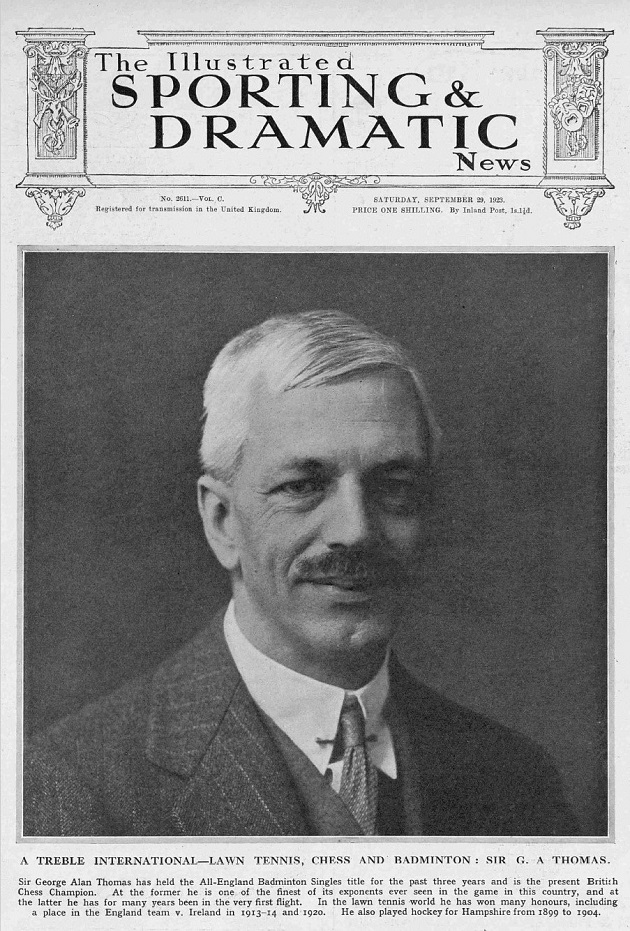
Edward Winter

See C.N. 10307 below.
***
A miscellany of Chess Notes items about Sir George Alan Thomas (1881-1972).
Tim Krabbé (Amsterdam) asks:
‘What were Sir George Thomas’s exact tennis results at Wimbledon? Some sources say he got to the quarter-finals there more than once.’
(1677)
Stewart Reuben (Twickenham, England) has received from Mr Alan Little, the Honorary Librarian of the Wimbledon Lawn Tennis Museum, a complete list of Sir George Thomas’s results:
1919: Gentlemen’s Singles: Round I: lost to P. O’Hara Wood 1-6, 8-6, 4-6, 7-5, 3-6.
1919: Gentlemen’s Doubles: Round I: with W.L. Clements lost by a walk-over against C.J. Griffin and W. Davis.
1920: Gentlemen’s Singles: Round I: beat W.A. Ingram 2-6, 6-2, 6-3, 6-3. Round II: lost to R. Lycett 6-2, 1-6, 3-6, 6-8.
1920: Gentlemen’s Doubles: Round I: with C.W. Murray beat E. Coutts and S.O. Brokensha by a walk-over. Round II: lost to S. Malmstrom and C.E. von Braun 6-2, 3-6, 6-8, 1-6.
1920: Mixed Doubles: Round I: with Miss H. Hogarth beat G. Stoddart and Miss D.S. Holmes 6-3, 6-1. Round II: lost to T.M. Mavrogordato and Mrs Parton 1-6, 6-4, 4-6.
1921: Gentlemen’s Singles: Round I: beat H.S. Milford 5-7, 6-4, 7-5, 7-5. Round II: lost to S.M. Jacob 3-6, 3-6, 1-6.
1921: Gentlemen’s Doubles: Round I: with C.F. Scroope lost to J.C.F. Simpson and A.B. Gravem 7-5, 8-6, 7-9, 5-7, 6-8.
1921: Mixed Doubles: Round I: with Miss Hogarth beat T. Moss and Mrs Mitchell by a walk-over. Round II: lost to C.F. Scroope and Mrs Armstrong 2-6, 7-5, 2-6.
1922: Gentlemen’s Singles: Round I: beat A.W. Dayson 2-6, 6-4, 6-3, 6-3. Round II: beat R. Dash 0-6, 6-2, 6-3, 6-4. Round III: beat S.M. Hadi 8-6, 4-6, 6-4, 7-5. Round IV (i.e. last 16): lost to J.B. Gilbert 11-9, 2-6, 6-3, 2-6, 0-6.
1922: Gentlemen’s Doubles: Round I: with P.F. Glover lost to R.C. Wertheim and H.S.L. Barclay 9-11, 2-6, 2-6.
1922: Mixed Doubles: Round I: with Miss Hogarth lost to A. Zerlendi and Mrs A.A. Hall 5-7, 4-6.
1923: Gentlemen’s Singles: Round I: bye. Round II: lost to D.M. Greig 4-6, 4-6, 2-6.
1923: Mixed Doubles: Round I: with Miss Hogarth lost to H.I.P. Aitken and Miss E.M. Head 2-6, 3-6.
1924: Gentlemen’s Singles: Round I: lost to F.R.L. Crawford 3-6, 6-3, 13-15, 3-6.
1924: Mixed Doubles: Round I: with Miss Hogarth lost to C. Fischer and Miss Sigourney 3-6, 2-6.
1925: Gentlemen’s Singles: Round I: beat R. Powell 0-6, 11-13, 6-0, 7-5, 7-5. Round II: lost to L.E. Williams: 1-6, 2-6, 2-6.
1926: Gentlemen’s Singles: Round I: lost to J. Kozeluh 0-6, 2-6, 2-6.
1926: Mixed Doubles: Round I: with Miss Hogarth lost to L.R.C. Michell and Miss P. Saunders 3-6, 2-6.
(1693)
Addition on 21 July 2023:
Andrea Aliferopulos (Gytheio, Greece) notes that there is now a Wimbledon webpage which gives a more extensive record. It shows that for the period (1919-26) covered in our earlier item (C.N. 1693, reproduced in C.N. 4115) one result is missing: Sir George Thomas’s loss in Round I of the Gentlemen’s Doubles in 1924. However, the website records that he also participated in competitions from 1906 to 1914, with no little success; for example, in the Gentlemen’s Singles he reached the Quarter-Finals in 1911, and in the Gentlemen’s Doubles he played in the Semi-Finals in 1907 and 1912.
This photograph of Sir George Thomas at Wimbledon in June 1921 has been provided, courtesy of the Keystone Archive, by Olimpiu G. Urcan (Singapore):

Andrew Kinsman (New Malden, England) has placed on the Internet an analytical query (raised by Neil McDonald) regarding the game between F.F.L. Alexander and Sir George Thomas in the 1919-20 City of London Chess Championship.
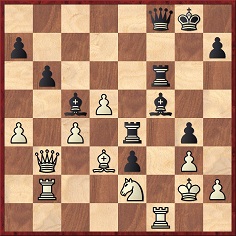
In section 25 of Chess Fundamentals Capablanca wrote that after 38 Nf4 Qh6 39 Qc2, ‘I take pleasure in offering the position to my readers as a most beautiful and extraordinary win for Black, beginning with 39...Qh3+!!! I leave the variations for the student to work out’.
Capablanca seldom accorded a move two exclamation marks, let alone three, but Neil McDonald believes 39...Qh3+ to be a blunder, refuted by 40 Nxh3 gxh3+ 41 Kh1 e2 42 Rbb1 exf1(Q)+ 43 Rxf1 Bg6 44 Rc1 Re3 45 Bxg6 hxg6, after which Black may still draw but is hardly winning.
The game has not been widely published, although Fred Reinfeld wrote on page 82 of A Treasury of British Chess Masterpieces (London, 1950) that Thomas’s finish was ‘one of the most beautiful conclusions in the whole range of chess literature’. Reinfeld referred to Capablanca and Chess Fundamentals but did not mention 39...Qh3+.
(2130)
As reported in a footnote on page 394 of Kings, Commoners and Knaves, Sir George Thomas diffidently nominated this game as his best performance. See The Best Chess Games, which quotes him as follows:
‘I find it uncommonly difficult to pick on a game to send you. To be honest – I have never played a game that completely satisfied me. However, I enclose a game [Alexander v Thomas, London, 1919] which has the merit of a rather entertaining combination, which was subsequently proved to be thoroughly sound. The play on both sides in the earlier stages of the game probably leaves much to be desired, but the long period in which the rook remains en prise is rather amusing.’
Annotating his move 31 Nd6 against Sir George Thomas at Carlsbad, 1923, Alekhine wrote in his first Best Games collection:
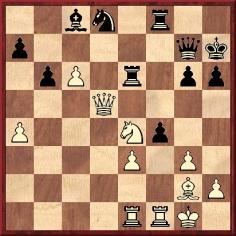
‘The winning move, of which the consequences, in the leading variation, had to be analysed 12 and 15 moves ahead.’
(2167)
See Long Calculation.
On pages 34-35 of the 14 September 1936 CHESS Euwe annotated his game against Sir George Thomas (White) at Nottingham, 1936. It began: 1 e4 Nf6 2 e5 Nd5 3 d4 d6 4 Nf3 Bg4 5 Be2 c6 6 O-O dxe5 7 Nxe5 Bxe2 8 Qxe2 e6 9 b3
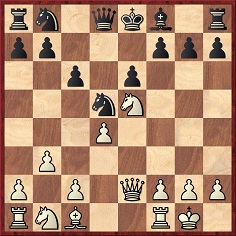
Now Euwe played 9...Nd7 and wrote, ‘Interesting here was 9...Nf4 10 Qe4 Qxd4 11 Qxd4? Ne2+ or 10 Bxf4 Qxd4 attacking both the rook and the bishop. But White plays 10 Qf3! Qxd4 11 Qxf4 Qxa1 12 Qxf7+ Kd8 13 Bg5+ and wins’.
On pages 83-84 of the 14 November 1936 issue a reader, H.T. of Hythe, pointed out that Euwe’s ‘interesting’ line loses owing to 10 Bxf4 Qxd4 11 Qd2, and if 11...Qxa1 12 Nc3 Qb2 13 Nc4.
(Kingpin, 1997)
Savielly Tartakower and Sir George Thomas were featured on page 20 of CHESS, 14 September 1936:
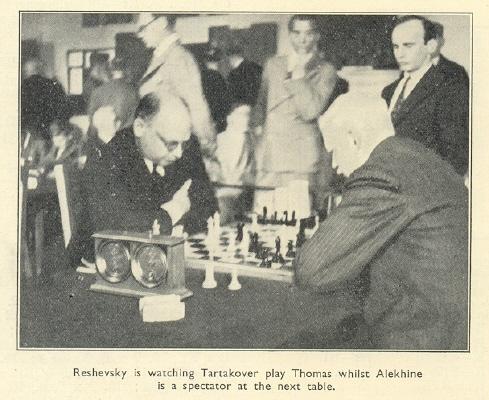
See Photographs of Nottingham, 1936.
Sir George Thomas once lost a game in 13 moves to the tournament tail-ender:
George Alan Thomas – Theodore Henry Tylor
Weston-super-Mare, 7 April 1926
Queen’s Gambit Declined
1 d4 d5 2 c4 e6 3 Nf3 c6 4 Nc3 Nf6 5 e3 Ne4 6 Bd3 f5 7 O-O Nd7 8 Ne1 Bd6 9 Bxe4 fxe4 10 Qh5+ g6 11 Qh6 Bf8 12 Qf4 Nf6 13 f3 Nh5 14 White resigns.
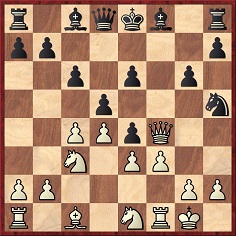
Source: BCM, May 1926, page 212.
(Kingpin, 1998)
Are ‘unspeakable’ and ‘characteristically inept’ justified descriptions of Larry Evans or have we been exaggerating? His 1998 book The 10 Most Common Chess Mistakes (Cardoza Publishing) provides an opportunity to judge. Although each page has little on it (just one position), Evans still manages to stockpile the blunders. ... For example, on page 45 (containing less than ten lines of text) Evans makes the following errors:
‘Thomas – Mitchell’; Black’s name was Michell.
‘London, 1932’; the game was played at the Hastings, 1932-33 tournament.
Wrong diagram, since the pawn at c5 should be black.
In his paragraph (a) Evans omits mention of the faster win 5 Re7+.
In his paragraph (b) he writes ‘Black actually lost’, whereas Black actually won.
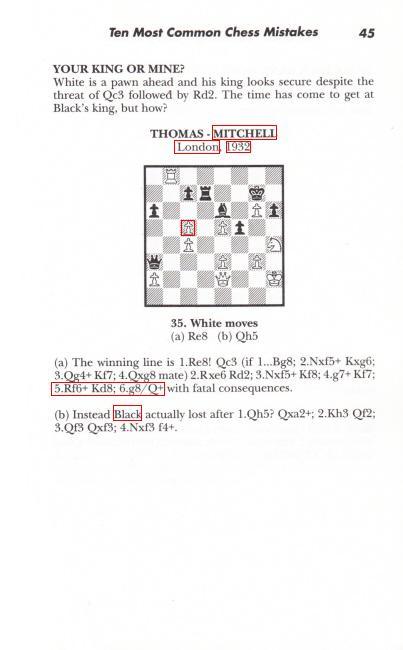
(2316)
Sir George Thomas on Vera Menchik:
‘Miss Menchik was not merely the best woman chessplayer the game has produced; she was so far ahead of the rest as to be in a class apart – the only woman who has won (and won beyond cavil) a place in the ranks of the masters. That is a fact clearly established by her record during the past 20 years or so. Equally true it is that her hold on the regard of the chess world was due as much to her other characteristics as to the force of her play. No one could wish for a more sporting or considerate opponent whether in success or in defeat, and I know no player less given to making excuses for failure or displaying undue elation when victorious. In spite of her unique position she was as unassuming today as when she started to climb the chess ladder – a pleasingly unaffected attitude equally free from “side” and from that false modesty which can be even more irritating. Consequently her triumphs were always popular and she had a host of well-wishers.’
Source: The Kipping Chess Club Year Book 1943-1944 (Liverpool, 1944), page 5.
(2923)
Sir George Thomas called the following game ‘exceedingly interesting’ at the conclusion of his detailed annotations on pages 210-212 of the May 1922 BCM:
Roland Henry Vaughan Scott – Edward Guthlac Sergeant
City of London Chess Club Championship, 1922
Queen’s Gambit Declined
1 d4 d5 2 c4 e6 3 Nc3 Nf6 4 Bg5 Be7 5 Nf3 Nbd7 6 e3 O-O 7 Rc1 b6 8 cxd5 exd5 9 Bd3 Bb7 10 Ne5 Nxe5 11 dxe5 Ne4 12 Bf4 c5 13 Qc2 f5 14 Nb5 g5 15 Bg3 f4 16 f3 fxg3 17 fxe4 c4 18 Be2 Bb4+ 19 Nc3 d4 20 Bxc4+ Kg7 21 Rd1
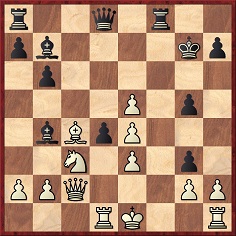
21…dxc3 22 Rxd8 cxb2+ 23 Rd2 Rad8 24 Qxb2 Bxd2+ 25 Qxd2 Rxd2 26 Kxd2 Rf2+ 27 Kd3 Rxg2 28 hxg3 Rxg3 29 Rf1 Bc8 30 Rf7+ Kg6 31 Rxa7 h5 32 e6 b5 33 Bd5 Bxe6 34 Bxe6 h4 35 Bf5+ Kf6 36 Ra6+ Kf7 37 e5 h3 38 Rh6 Resigns.
(2494)
The problems below, both four-movers, were published on pages 127-128 of An English Bohemian: A Tribute to B.G. Laws by J. Keeble (Stroud, 1933):

Mate in four
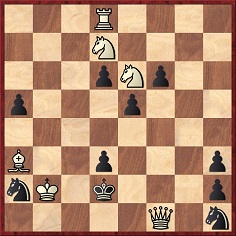
Mate in four
The former composition by Laws is captioned ‘Leeds Mercury, 1889 (Version in Chess Monthly, 1894)’. It appeared on page 61 of the October 1894 Monthly, with the solution (1 Qd2, etc.) given on page 379 of the August 1895 issue. A computer check shows that there is a second solution: 1 Qg4+.
In Keeble’s book the second problem had as its source ‘British Chess Magazine, February 1894’ with the intriguing comment (after the solution beginning 1 Nd4): ‘Stated in the British Chess Magazine to be cooked, but later found, we believe, to be quite correct.’ The BCM had presented it in colour as its thousandth problem (February 1894 frontispiece), and the following rather strange wording was used on page 124 of the March 1894 issue:
‘The solution of this very fine composition is as follows: 1 Nd4 [followed by eight lines of variations]. A few solvers have pointed out a second solution by 1 Nb6, etc. This can be easily avoided.’
One of those listed as giving a ‘correct’ solution to Laws’ composition was ‘Geo A. Thomas’, whom we take to be the future Sir George, although he would have been only 12 at the time.
A computer check confirms the existence of an alternative mate in four beginning with 1 Nb6.
Those interested in Zukertort’s self-promotional claims may wish to know that Keeble raised the subject on page 19 of the book, which was part of Alain C. White’s Christmas series.
(2789)
An anecdote presented by Chernev on page 17 of The Bright Side of Chess:
‘At Margate, in 1935, the height of hero worship was reached when a little boy approached a spectator of the tournament and asked him for his autograph. The onlooker explained that he was not a great chessplayer, nor was he particularly gifted in any other field. In short, his autograph could not possibly have any value. “But please, sir”, said the boy, “I saw you talking to Capablanca!”’
We are unable to say what source for this was available to Chernev, who was writing in the late 1940s, but Heinrich Fraenkel’s Foreword to Capablanca’s Last Chess Lectures (London, 1967) has the following on page 9:
‘I well remember seeing a good deal of Capa at the Margate tournament of 1935, where I played in the “Premier Reserves”; on one occasion I had the somewhat embarrassing experience of more than a hundred people crowding round my board, all of them turning their backs to my game. And who could blame them since at the next board, some 15 or 20 feet away, Capa was playing Reshevsky. I too would have preferred watching their game rather than playing my own.
Capa’s popularity with the “fans” was as immense as it was genuine. At some tournament, I forget which, I was chatting to Sir George Thomas when a small boy handed up his autograph book, which Sir George promptly signed. Then the boy handed the book to me and when I told him that surely there could be no point in getting my autograph he disagreed. “Oh yes, sir”, he said, “I must have your autograph too.” “But why on earth? It’s no good in your collection.” – “Oh yes, sir”, said the boy, his face beaming, “I saw you talk to Capablanca!”’
To avoid any misunderstanding, we add that Fraenkel’s Foreword is absent from the US edition, Last Lectures (New York, 1966).
See Chess Anecdotes.
Below is a photograph of the participants in Spa, 1926:
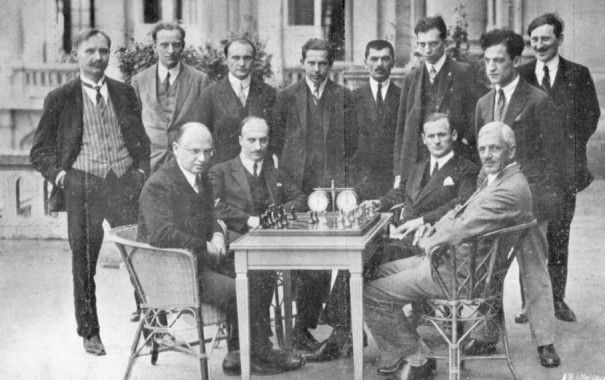
From left to right (standing): A.
Lenglez, M. Varlin, A. Tackels, A. Dunkelblum, V. Soultanbéieff,
I. Censer, G. Koltanowski, J. Davidson.
Seated: S. Tartakower, M. Romih, F. Sämisch, Sir George Thomas.
(3554)
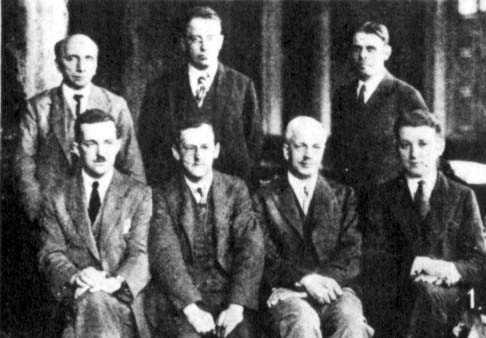
This is a rare group photograph of the players in the Cheltenham, 1928 tournament. Standing (left to right): W.H. Watts, J.A. Seitz, E. Znosko-Borovsky. Seated: C. Mansfield, F.D. Yates, Sir George Thomas, V. Buerger. Absent: J.A.J. Drewitt.
The picture appeared in the Cheltenham Chronicle and Gloucestershire Graphic of 14 April 1928 and was reproduced on page 181 of The Gambit, June 1928.
(3597)
A group photograph from London, 1927:
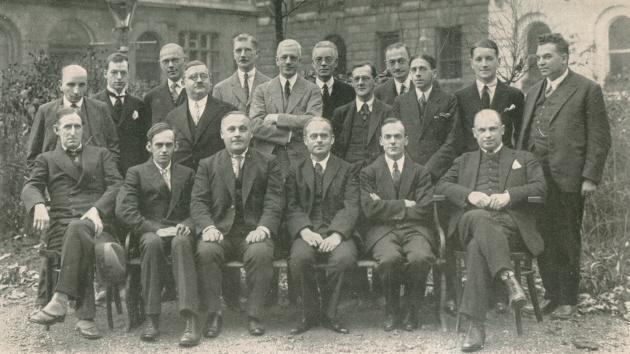
Seated from left to right: F.J.
Marshall, W. Winter, E. Bogoljubow, A. Nimzowitsch, W.A.
Fairhurst, S. Tartakower.
Standing: W.H. Watts, M.E. Goldstein, H. Kmoch, M. Vidmar, R.C.
Griffith, Sir George Thomas, E. Busvine, F.D. Yates, J. Schumer,
E. Colle, V. Buerger, R. Réti
(3959)
From an article entitled ‘Glimpses of Alekhine’ by M.E. Goldstein on pages 86-87 of Chess World, 1 May 1946:
‘As con-translator with J. du Mont ... of the French MSS of Alekhine’s book My Best Games of Chess 1908-1923 I naturally met the maestro on a number of occasions. In 1926 we both competed in the Scarborough tournament, and I lost in 40 [sic] moves.
In this tournament Alekhine upbraided me for failing to do more than draw against Sir George Thomas, a game in which I had only a minimal advantage. In fact, even Alekhine’s genius failed to reveal any winning line in the inevitable post mortem.
Alekhine said, “Now I’ll have to beat my old school friend, Victor Khan, or Thomas may come ahead of me.” He did, which was just as well, as Thomas was only half a point behind.
Until well into the small hours of the mornings, Alekhine, Bogoljubow, Colle, Sir George Thomas and myself used to play “Two-Move Chess”. In this fantastic form of the game, a player is permitted to make two moves at a time, provided he does not check on the first move.
Alekhine proved a past-master in this game also; his ability to check on the second move and thus restrict his opponent’s choice was one reason for his superiority over the other players.’
C.N. 3964 mentioned that Alekhine also won a Kriegspiel tournament while in Scarborough.
Goldstein’s account might be taken to imply that his draw against Sir George Thomas occurred at the end of the tournament, but page 303 of the July 1926 BCM states that it was played in the third round of seven. Before the seventh round the leading scores were Alekhine 4½ and Sir George Thomas 4. Both won their final games.
From the same issue of the BCM comes this photograph taken in Scarborough, although not during play in the tournament:
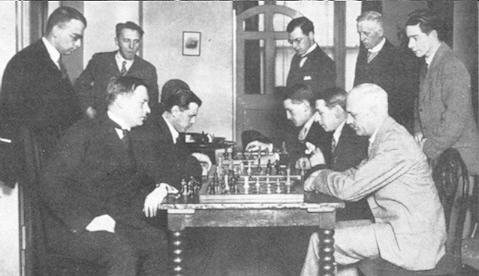
At the board (left to right and from the front) are A. Alekhine and Sir George Thomas; E. Znosko-Borovsky and E. Colle; S. Landau and V. Buerger. The players standing are A. Seitz, V. Kahn, M.E. Goldstein, C.Y. Dawbarn and G.M. Reid.
(3981)
It was not until Capablanca had lost his world championship title that he became relatively active in living chess. This photograph shows him with Sir George Thomas at Ramsgate in 1929.
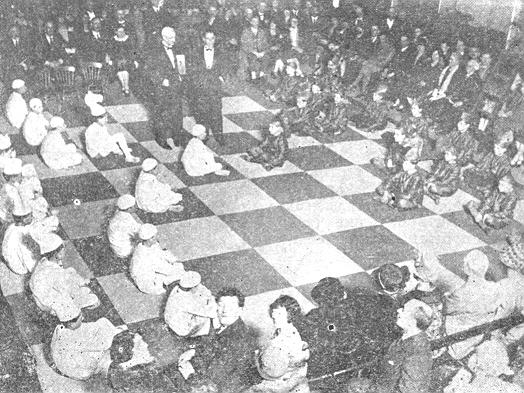
‘Fifty Ramsgate schoolboys, all chessplayers, represented the pieces, and players were mounted on ladders – the type used by tennis umpires’, was the description on page 102 of the May-June 1929 American Chess Bulletin, which also reported on another such spectacle:
‘A “living chess” display was given in the Great Hall of the Regentenbau on 19 August. It was said to be the best ever given. Kissingen made it practically a city function. The “pieces” wore old Bavarian costumes, and their movements were directed by the court jester. The chess side of it was naturally arranged for spectacular purposes. Dr S. Tarrasch played a “skittle” game against E.D. Bogoljubow, and then J.R. Capablanca took the black forces against F.J. Marshall, this game ending in a draw by perpetual check, the white queen making the necessary moves to that end.’
(4092)
Footage of old events (such as living chess displays featuring Capablanca and Alekhine, against Sir George Thomas and Bogoljubow respectively) can be viewed at the following site: http://www.britishpathe.com.
(3491)
A group photograph (Canterbury, 1930) was published on page 205 of the June 1930 BCM:
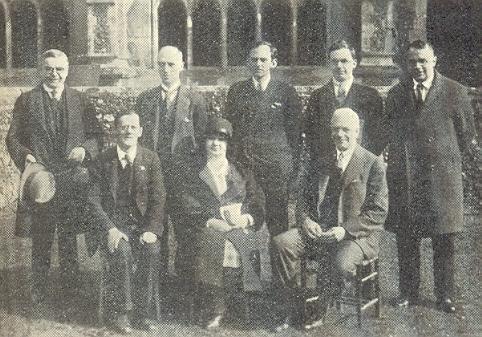
Standing (left to right): H.E.
Price, E. Spencer, W. Winter, G. Abrahams, A. Seitz
Seated: F.D. Yates, V. Menchik, Sir George Thomas
(4350)
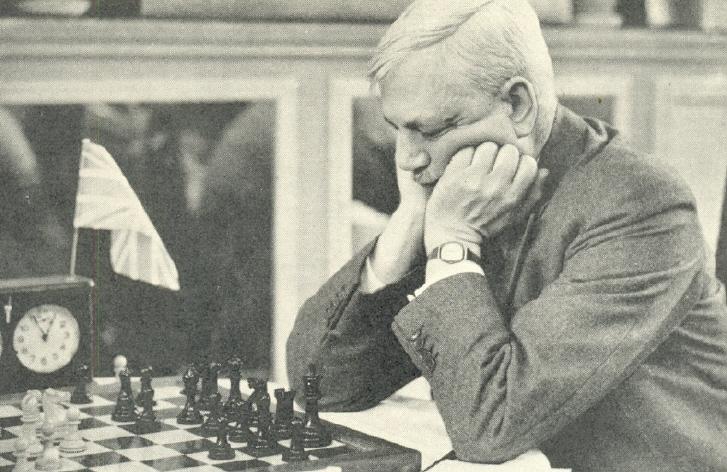
Source: page 115 of Alt om Skak by Bjørn Nielsen (Odense, 1943)
Sir George Thomas accused himself of ‘funk’ regarding the conclusion of his game against Capablanca at Carlsbad, 1929.
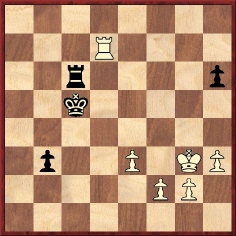
In this position Sir George (Black) played 47...Rd6, and a draw was agreed upon. However, page 43 of Assiac’s The Delights of Chess (London, 1960) quoted a brief comment he wrote at the end of his game-score:
‘Draw agreed. A case of funk. Black should win the ending.’
On the following page Assiac remarked that ‘readers can easily see for themselves that the game was won for Black, and without much risk either’. We wonder, though, how clear-cut matters are.
On page 53 of the Carlsbad, 1929 tournament book Alfred Brinckmann wrote that the draw after 47...Rd6 was justified, as thorough analysis showed that Black could not win:
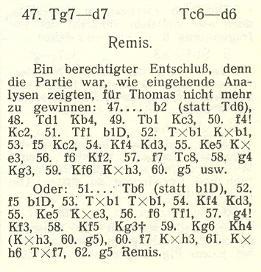
Similar analysis was given (without mention of Brinckmann) in the annotations booklet which accompanied the Weltgeschichte des Schachs volume on Capablanca by James Gilchrist and David Hooper (Hamburg, 1963):
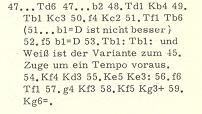
See too page 89 of the second volume of the ‘Chess Stars’ book on Capablanca (Sofia, 1997), which also offered only a draw, although one further move (48 Rc7+) appeared in the game itself:
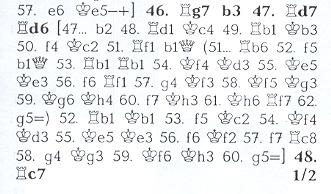
Has a winning method for Black at move 47 ever been demonstrated?
(4727)
Yasser Seirawan (Amsterdam) writes regarding Capablanca v Thomas, Carlsbad, 1929:

‘A quick impression is that Black should win by direct means after 47 Rd7: 47...b2 48 Rd1 Kb4 49 Rb1 Kb3! 50 f4 Rc1! 51 Rxb2+ Kxb2 52 Kh4 (With the rook now on the first rank the advance 52 f5 is a mistake as 52...Rf1 53 e4 Kc3 makes the task easy.) 52...Rc6! (Covering the h6-pawn, cutting off the white king and preparing to bring the black king into play.) 53 g4 Kc3 54 Kh5 Kd3 55 g5 hxg5 56 fxg5 Ke4, and Black is in time to stop the pawns for a win.
This is by no means an exhaustive analysis, but just a check of the direct line. It is possible that 50 f4 is wrong, but I based my analysis on that move as it seemed to be the main line of others.’
(4730)
From Dennis Monokroussos (South Bend, IN, USA):
‘Regarding the interesting and surprisingly complex Capablanca-Thomas endgame, Yasser Seirawan addresses 52 Kh4 and 52 f5, correctly noting that both moves lose. White has a third possibility, however: 52 Kg4. This prepares to shoulder off the black king and should be good enough for a draw. For example: 52...Rc6 53 f5 Kc3 54 Kf4 Kd3 55 Ke5 Kxe3 56 f6, with a drawn position. One possibility is 56...Kf2 57 f7 Rc8 58 g4 Kg3 59 Kf6 Kxh3 60 g5 hxg5 61 Kxg5, followed by Kg6-Kg7-f8(Q).’
Yasser Seirawan comments:
‘The idea proposed by Mr Monokroussos is a very good one. His plan of shouldering away Black’s king in the line he gave after 52...Rc6 was certainly missed by me. I likely entertained 52 Kh4 as the main move in order to prepare g2-g4 in one go, so to speak. The move 52 Kg4 invites Black to play 52...Rg1, putting the rook behind White’s g-pawn with the gain of a tempo, which is why I rejected the move. However, White can draw by jettisoning the g-pawn with 52...Rg1 53 Kh5 Rxg2 54 Kxh6 Kc3 55 f5 Rf2 56 Kg6 Kc4 57 h4 Kd5 58 h5, when Black has various tries, but White is fast enough. For example: 58...Kd6 59 h6 Ke7 60 h7 Rg2+ 61 Kh5 Kf7 62 h8(N)+ Kf6 63 Ng6, and the knight escapes thanks to the help of White’s pawns.’
(5820)
C.N. 4726 asked who was the last surviving master who had come into personal contact (not necessarily over the board) with J.H. Zukertort (1842-88). The person we had up our sleeve was Sir George Thomas (1881-1972), but we note now that the wording of Assiac’s account on pages 47-48 of The Delights of Chess (London, 1960) indicates that ‘personal contact’ did not occur:
‘Having met so many of his contemporary masters – contemporary through several generations and ranging from Steinitz and Chigorin through Lasker, Pillsbury, Tarrasch to Keres and Reshevsky, Penrose and Petrosian – Sir George has some fascinating stories to tell about many of them. Indeed, Zukertort would seem to be about the only one of the “old-timers” he never met to speak to, though he saw even him at a (respectful) distance while admitted to his mother’s drawing-room as a child of six or seven.’
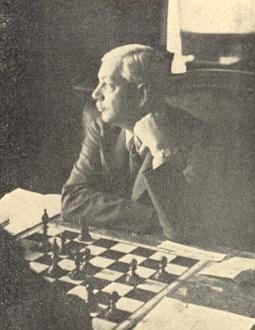
Sir George Thomas
(4764)
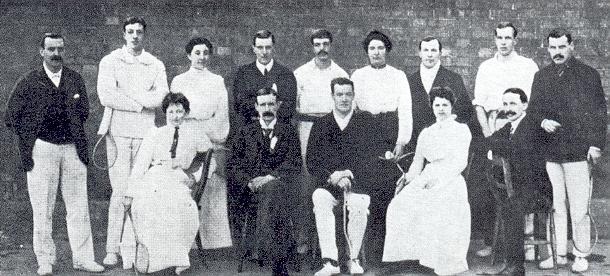
Standing in the middle is George Thomas, the photograph having been taken at ‘the first-ever badminton international – Ireland versus England, Dublin 1903’. It was published on page 39 of The Badminton Story by Bernard Adams (London, 1980).
(4884)
From page 75 of the above-mentioned book:
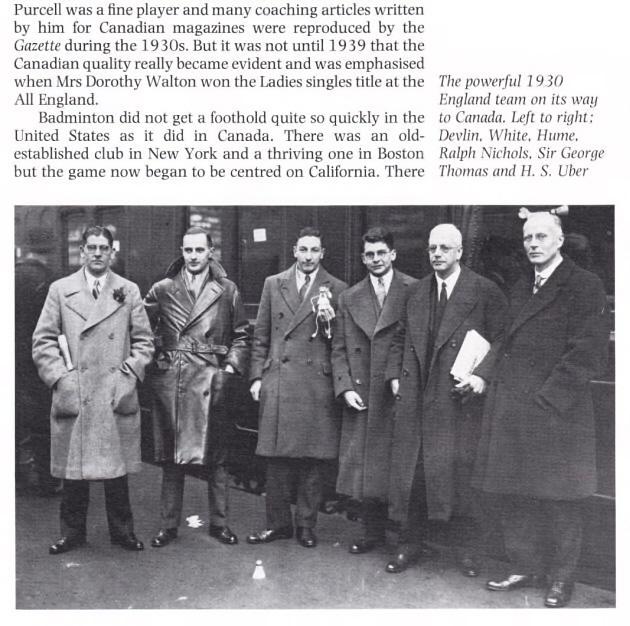
(8270)
The Christmas 1969 issue of CHESS had a quiz which claimed (on pages 116 and 125) that D. Janowsky ‘was so annoyed at reaching a losing position against Sir George Thomas’ that he ‘did not arrive for resumption of play, and the tournament director upon opening the envelope merely found the word “abandonnent”.’ No occasion was specified or source given, but it seems that Janowsky’s only loss to Sir George Thomas was at Marienbad, 1925 – an 88-move game given on pages 96-97 of the tournament book.
In an article entitled ‘Unconventional Surrender’ on page 55 of the February 1950 Chess Review Hans Kmoch and Fred Reinfeld stated that such an incident occurred in the game between Müller and Yates at Kecskemét, 1927, and that White sealed ‘aufgegeben’. See page 130 of Reinfeld’s The Treasury of Chess Lore (New York, 1951). Kmoch was a participant in the tournament.
(4942)
A passage on page 49 of The Delights of Chess by Assiac (London, 1960) has come to our attention:
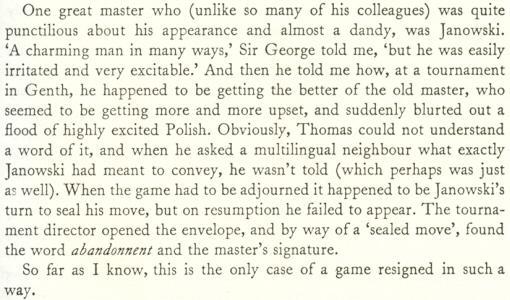
The two masters played each other twice in a 1926 tournament in Ghent, but both games were drawn.
(5287)
Roland Kensdale (Aberdeen, Scotland) mentions that Jim Phelan was featured in the chapter ‘Chess in Captivity’ in Chess Pieces by Norman Knight (London, 1949). Our correspondent comments:
‘In his Foreword Sir George Thomas recalled (pages vii-viii) a simultaneous display which he gave in Parkhurst Prison while Phelan was an inmate:
“It has saddened me to learn from the section ‘Chess in Captivity’ that chess contact between the inmates of Parkhurst and the outside world has been discontinued. A simultaneous display I gave there, in the days of the author of Walls Have Mouths, is among the most prized of my chess memories. It was easy to sense what that short break meant to the prisoners. Never before or since have I had opponents so completely absorbed in the game, or been so conscious myself of a bond uniting us. When play was over, Jim Phelan – who appears in Walls Have Mouths – made the neatest speech of thanks I have ever heard; and another of the players gave me a sachet, made out of a piece of an old shirt and filled with lavender. My own enjoyment was marred only by the moment of departure; going into the fresh evening air and knowing that behind me keys were turning. Wholeheartedly I endorse Mr Knight’s plea for the encouragement of the game in every penal institution in the country.”
It is on pages 201-207 that the chess club at Parkhurst Prison is mentioned in an excerpt from the book Walls Have Mouths by Wilfred Macartney (London, 1936).
On pages 209-210 some of Phelan’s writing is quoted from CHESS, October 1943 (page 13). This includes a poem about play at Parkhurst.’
(5066)
See our feature article on Phelan, which also includes the text below:
Sir George Thomas’s visit to Parkhurst Prison was reported on pages 543-544 of the December 1935 BCM:
‘Sir George Thomas has been giving many simultaneous displays on behalf of the Nottingham Chess Congress, 1936. ... One which gave a great deal of pleasure was at H.M. Prison, Parkhurst, Isle of Wight. He played 16 members of the prison chess club, including the chaplain, who is the president. Sir George won them all, although several games were well contested. The chaplain proposed a vote of thanks, and this was very ably seconded by one of the convicts, who hoped Sir George would realize what pleasure it gave them to have a game with such a renowned chessplayer.’
The exhibition was also mentioned on page 7 of the Daily Mail, 4 November 1935:
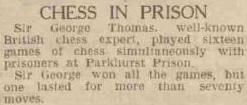
As will be seen below, the lengthy game was against Phelan.
A further newspaper report (Nottingham Evening Post, 28 April 1937, page 4) gave general information about chess in Parkhurst Prison:
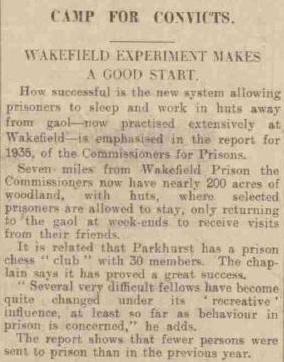
Below is the obituary of C.F. Chapman on page 185 of the June 1949 BCM:
‘C.F. Chapman died at Bournemouth on 23 April at the age of 84. He will be remembered as a Past President of Dorset C.A. and Hampshire Chess Association, and a Vice-President of Sussex. At different times he held the championship of the Brighton, Bournemouth, Parkstone, Eastbourne, Chichester and Isle of Wight clubs; but perhaps he will be best remembered for his work in introducing chess to Parkhurst Prison during his sojourn in the Isle of Wight. This was well written up in the book on prison life Walls Have Ears – F.L.T.’
As noted above, the book was entitled Walls Have Mouths.
The book by Phelan with the most references to chess is Jail Journey (London, 1940), e.g. on pages 75, 120, 140, 160, 188, 285-286, 298, 306-307, 331, 333-336, 349-350, 359-364, 369, 374-376, 381. On pages 374-376 he discussed Sir George Thomas’s visit to Parkhurst Prison in 1935:
‘I still went to the Chess Club on Saturdays, but I was not the Club champion now, not least for a time. Only once, for a week or so, I recaptured some of the old fierce energy, when Sir George Thomas came down to play against us. Thomas was in the champion class, has held the British Championship, would never insult a player by giving him the slightest chance or patronizing him in any way. To play against Thomas was going to be an intellectual and emotional treat for most of us. Not least for me. After all, the Club was my baby, born after years and not months of travail in the strangest home in the world. Thomas going to be a fine god-parent.
It is laughable now, but I was furious at the time; things nearly went wrong. There was no need to school my players. They knew chess etiquette, and grave punctilio, as well as any men in Europe. They would not let the jail team down. Yet Thomas was nearly embarrassed after all.
It will have been guessed that not every jail-employee saw eye-to-eye with Clayton about “letting people play chess”. In the early days of the Club there had been many ludicrous clashes with groove-minded officials who could not understand that times had changed, that it was no longer “days gone by”. (“Lee don f’r chess. ’Alt. C’mmence chess.” As if arrogant people like Macartney or myself – with official backing – could tolerate that kind of nonsense.) Lately things had been moving more smoothly; no-one tried to be obstructive; Scott had continued, and backed, the Chess Club, exactly as Clayton had done.
Thomas came. He played all of us. Time passed. The session was longer by far than most similar plays “outside”; we were rather tough nuts to crack. The hour for finishing had gone by. We ought to be in our cells. We played on. At the first board, I was organizer, secretary, semi-grass watcher that everything went well, buffer between Thomas and intruding screws, and I was also playing Sir George. Our game had gone 70 moves. I was going to draw. I knew I was going to draw. Now this was something to be conceited about.
And a voice said barkingly: “Pack up. Lee don outside.”
I did not wish to kill the man, did not even, I insist, desire to kick him again and again in the mouth! Such is the superhuman self-control of the skilled chess-thinker. I advanced from my place, hoping Thomas would not have understood. The boys were looking at me anxiously. On the command, they should have filed silently outside, leaving Thomas in an empty room with some useless chess-men. No-one moved.
Blakely from Ryde was there, a civilian chessplayer who had a semi-official status. Blakely backed me up, and we wafted the zealot outside, stilling his murmurs that it was “past time now. Bell’s gone”. He wasn’t even in charge either! Just a zealous exponent of the code, demonstrating that courtesy, decency, sensitiveness or consideration for the feelings of others cannot possibly exist in an illiterate degraded convict! Or something like that. Presently the man in charge appeared, a little later the Chief showed up, and all was quiet again. I went back to my board, made my move, lost my game. Curse that groove-brained code-mumbler!
After that match, soon and swiftly, I dropped quietly off into a routine of nothingness.’
Harry Golombek reviewed Jail Journey on page 192 of the June 1940 BCM:
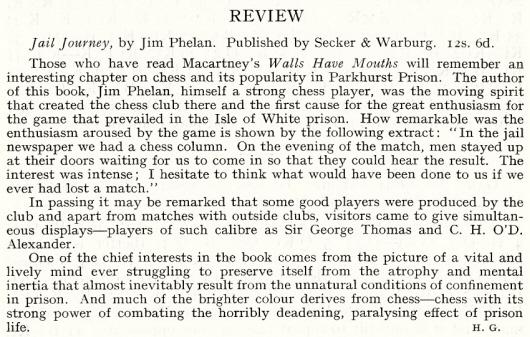
From page 54 of Chess Marches On! by Reuben Fine (New York, 1945):

Elsewhere (e.g. on page 73 of CHESS, December 1972) the observation has been quoted as a remark by George Koltanowski to Sir George Thomas.
An editorial note (by B.H. Wood) appeared at the end of an article by Koltanowski on pages 180-181 of the 14 January 1936 issue of CHESS:
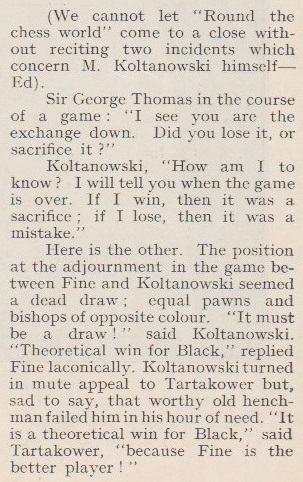
On page 87 of With the Chess Masters (San Francisco, 1972) Koltanowski named E.S. Tinsley as his interlocutor and referred to his queen, and not the exchange:
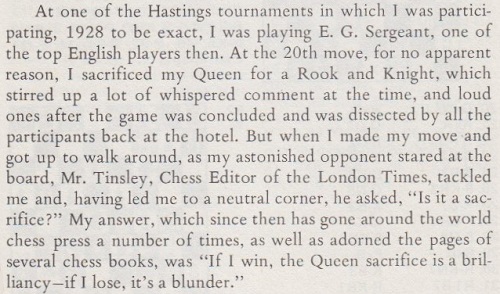
The following page showed the game (Koltanowski v E.G. Sergeant, Hastings, 31 December 1928), which reached this position after Black’s 19th move:
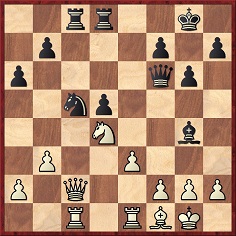
No notes were supplied, but Koltanowski punctuated his next move, Qxc5, with ‘?!’. The game was also published, storyless, on pages 83-84 of his book Chessnicdotes 1 (Coraopolis, 1978) with notes from The Field (and one analytical addition by Koltanowski towards the end of the game).
On page 54 of the second volume of Chessnicdotes (Coraopolis, 1981) it was back to Sir George Thomas and the ‘exchange’ version from CHESS in 1936:

(4951)
Jan Kalendovský (Brno, Czech Republic) has been trying to identify all the figures in the group photograph of Marienbad, 1925:
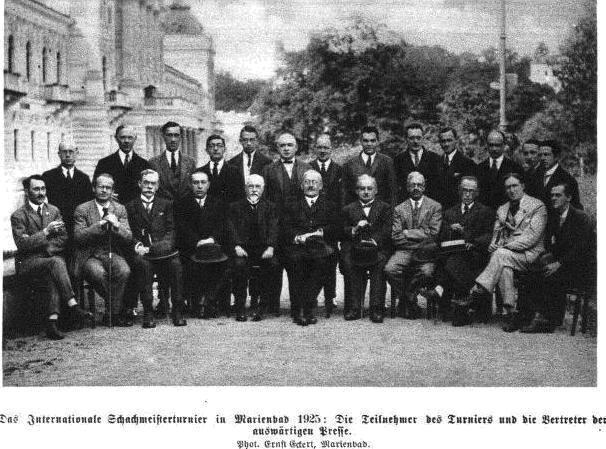
He offers the following:
‘Seated (left to right): N.N., A. Nimzowitsch, R.P. Michell, A. Rubinstein, I. Gunsberg, N.N., V. Tietz, Sir George Thomas, D. Janowsky, F.J. Marshall, F.D. Yates
Standing: L. Burian, H. Kmoch(?), M. Walter, C. Torre, N.N., D. Przepiórka, R. Spielmann, R. Réti, E. Grünfeld, F. Sämisch, S. Tartakower, A. Haida, K. Opočenský.’
The photograph appeared at the start of the tournament book, with the caption ‘Tournament participants and guests’ (‘Teilnehmer und Gäste des Turniers’). Mr Kalendovský reports that it was originally published on page 8 of the Wiener Bilder, 7 June 1925.
(5119)
Alan McGowan (Waterloo, Canada) mentions that a key to the Marienbad, 1925 group photograph was published on page 89 of the May-June 1925 American Chess Bulletin. The additional information it supplies is:
(5125)
A larger version of the Marienbad, 1925 group photograph.
The tournament book also included the following:
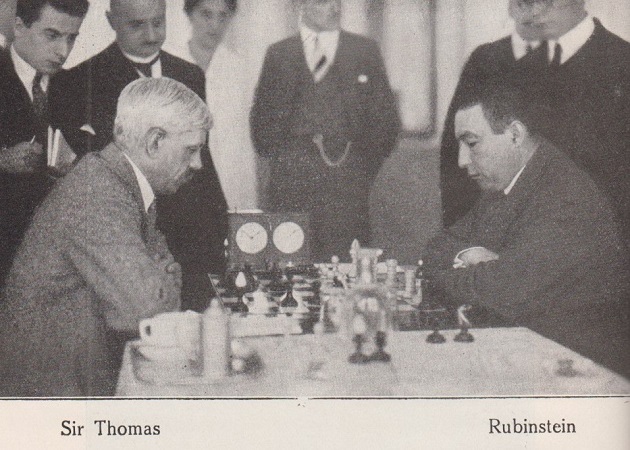
(9844)
On the subject of near-identical photographs, one instance concerns Carlsbad, 1929. The familiar group picture appears on, for example, page 97 of A Picture History of Chess by Fred Wilson (New York, 1981), but it is not quite the same as the one on page 289 of David DeLucia’s new book (C.N. 5323).
(5732)
We are grateful to Patrick Neslias (Esse, France) for the ‘other’ Carlsbad, 1929 group photograph:
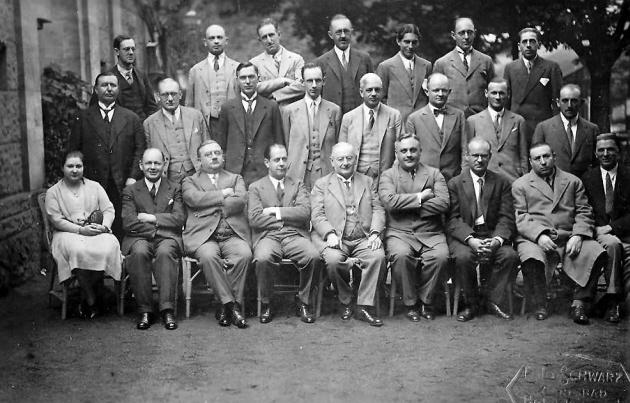
(6709)
From page 176 of the June 1939 issue of the Tijdschrift van den Koninklijken Nederlandschen Schaakbond:
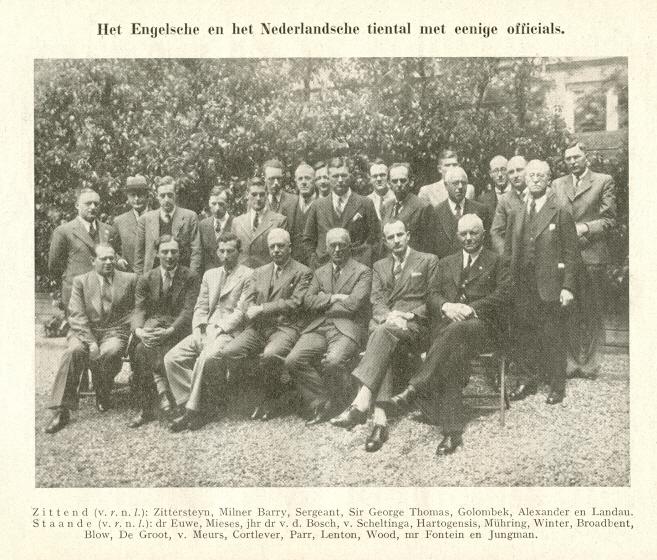
The occasion was the match between Holland and England in the Hague, 28-29 May 1939.
(5116)
Harrie Grondijs (Rijswijk, the Netherlands) draws attention to an illustration opposite page 288 of the May 1935 issue of El Ajedrez Español:
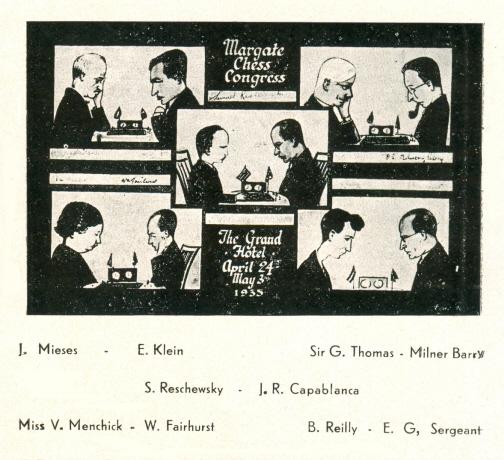
(5202)
This Nice, 1930 group photograph was published on page 68 of the April 1930 American Chess Bulletin:
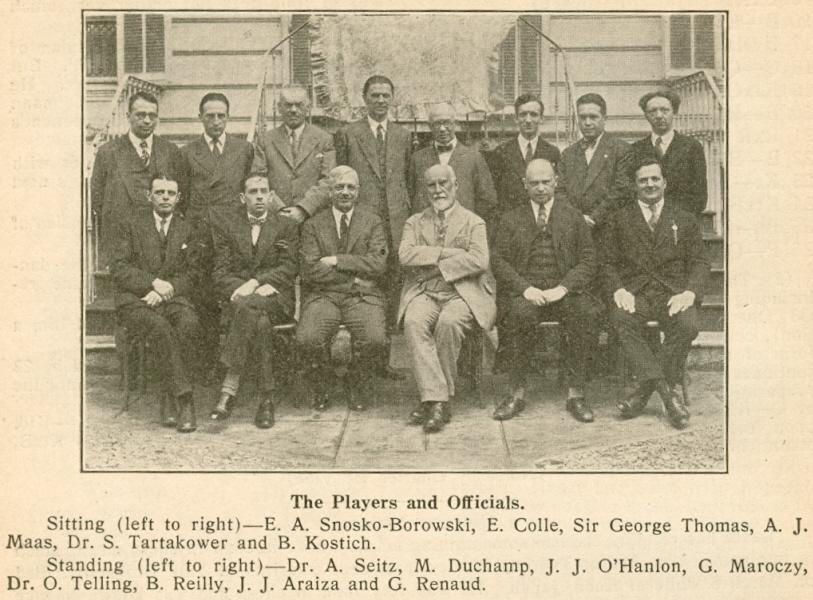
(5319)
Further to our feature article on Sultan Khan, Steven Pla (Albuquerque, NM, USA) asks whether any of the master’s game-scores at ‘old chess’ (shatranj) are extant.
We recall none. It may be noted, though, that page 268 of The Encyclopedia of Chess Variants by David Pritchard (Godalming, 1994) gave the moves of a game of shatranj between Herbert Jacobs and George Thomas at the City of London Chess Club in 1914. Did either player contest games of shatranj against Sultan Khan during the latter’s brief period in Europe (1929-33)?
(5645)
From an article by Alekhine in the New York Times, 25 August 1929, pages 1 and 2 of the Sports Section:
‘Sir Thomas [sic] and Yates are typical representatives of the English school and style of chess, especially Yates. This school, founded by the great combination of players, Blackburne and Mason and the ingenious, although less profound, Bird, always lay greater stress on a thorough study of each tactical unit of a scheme than on judging the expediency of such a scheme.
That they had good results despite such a primitive conception of chess was due, especially by Blackburne, first to their extraordinary combinatorial talent and, second, to the fact that Steinitz’s epoch-making explanations of the principles of chess strategy were then only beginning to become popular.
This is quite different nowadays when every average champion is well equipped with strategical knowledge, especially those players who lay chief stress on the tactical moment in a match, and who must possess the most exact calculation and never-failing sharpness. For such types of players the signs of the older class are simply pernicious. Therefore it is not surprising that masters like Sir Thomas [sic] and Yates – who also in former times seldom detected the entire plan beyond a single move – are being driven to the background of the chess arena.’
See Alekhine on Carlsbad, 1929.
A group shot taken at Edinburgh, 1920 was published on page 277 of the September 1920 BCM:
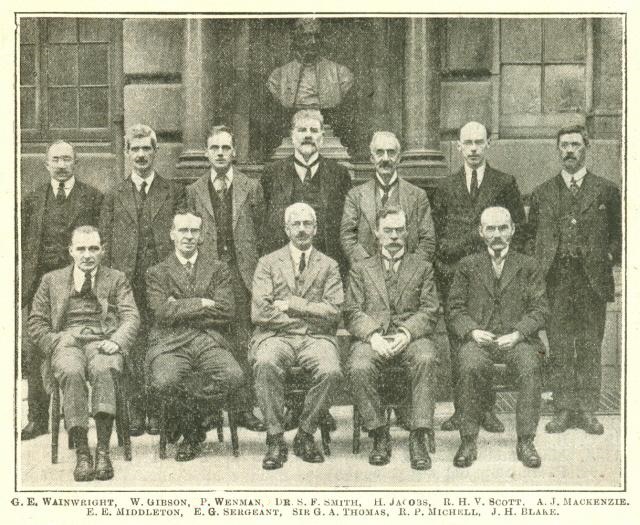
(5641)
Relatively little has been written about Sir George Thomas’s
chessplaying mother, Lady Edith Margaret Thomas (née
Foster). With the Family Search webpage it takes only a few
moments to find out that she was born circa 1853 at The
Bogue, St Elizabeth, Jamaica. See also The Family of
Col. John Foster, 1681-1731, from Elim, Jamaica. [Link
broken.]
When Lady Thomas died in 1920 the BCM (April issue, page 99) published this photograph of her:
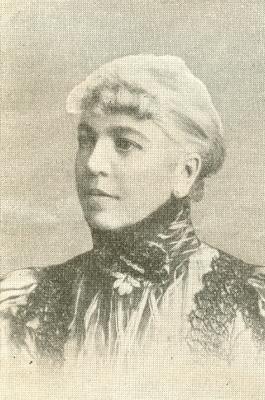
Below are some excerpts from a fulsome article about her (‘A Chat with the Lady Chess Champion’) on pages 255-256 of Woman’s Life, 18 January 1896:
‘No doubt my readers will remember that she won the first prize at the International Tourney at Hastings. [Sic. See page 16 of the Chess Monthly, September 1895.] Lady Thomas comes of a chessplaying family; her brother, Mr William Erskine Foster, was a brilliant player and was, at one time, a pupil of Mr Steinitz; her son, a particularly bright clever lad of 14, is also a proficient player.
“George beats me”, says Lady Thomas, “indeed I am now learning from him; we play every evening when at home; we are always playing – even when sitting on the beach we make a table of our laps and play; after, and before luncheon – in fact, we play nearly all day long.”
... Lady Thomas is a skilful player in several games. The second drawing-room is marked out for badminton and, when wet, the Turkey carpet is rolled up and they indulge in the fun of having exercise and amusement indoors. She is also a brilliant billiard player and cyclist.
... While in Constantinople, Lady Thomas was the only lady who rode about unattended into the country, and she never met with any molestation, though, as a precaution, she had a pocket made to her saddle to carry a revolver.
... Lady Thomas is Lady of the Manor of Marston, in Bedfordshire, and a daughter of the late Morgan Hugh Foster, Esq, C.B., who was for many years Governor of the Imperial Ottoman Bank.’
There follows a specimen of her tournament play, from pages 236-237 of La Stratégie, 15 August 1897:
Lady Edith Margaret Thomas – Miss Watson
London, 23 June 1897
Nimzo-Indian Defence (by transposition)
1 d4 d5 2 c4 e6 3 Nc3 Bb4 4 e3 Nf6 5 Bd3 Nc6 6 Nf3 Bd7 7 Bd2 Bxc3 8 Bxc3 dxc4 9 Bxc4 Ne4 10 Qb3 Nxc3 11 Qxc3 Qf6 12 Rc1 O-O 13 O-O Ne7 14 Bd3 Nd5 15 Qd2 c6 16 Ne5 Qe7 17 f4 f5 18 Rf3 Be8 19 Rh3 Nf6 20 Qe2 g6 21 Qf2 Ne4 22 Qf3 Nf6 23 Rf1 Rc8 24 Qg3 Ne4 25 Bxe4 fxe4
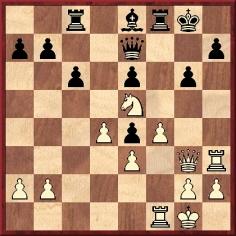
26 Ng4 Kh8 27 Nh6 Rc7 28 Rh4 Qd7 29 Qg5 Qd6 30 Ng4 Rf5 31 Qh6 and Black lost on time.
(5690)
‘Sir George A. Thomas’, ‘Sir Thomas’, ‘Sir George Thomas’ and ‘Sir G. Thomas’ all appeared on page 35 of the February 1935 Chess Review:
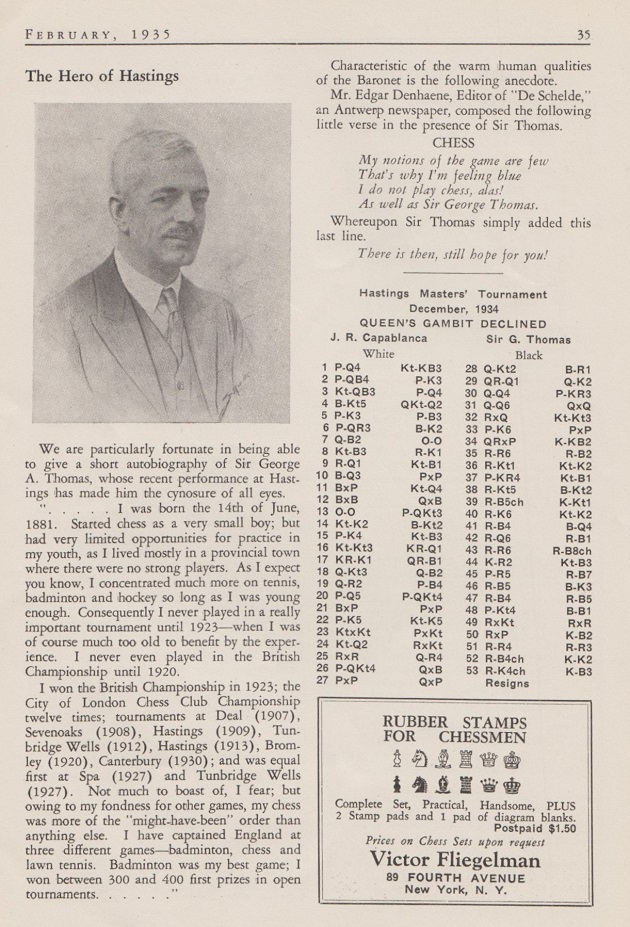
The autobiographical note was given in C.N. 7088. Another item about Sir George comes from page 133 of the May 1920 BCM:
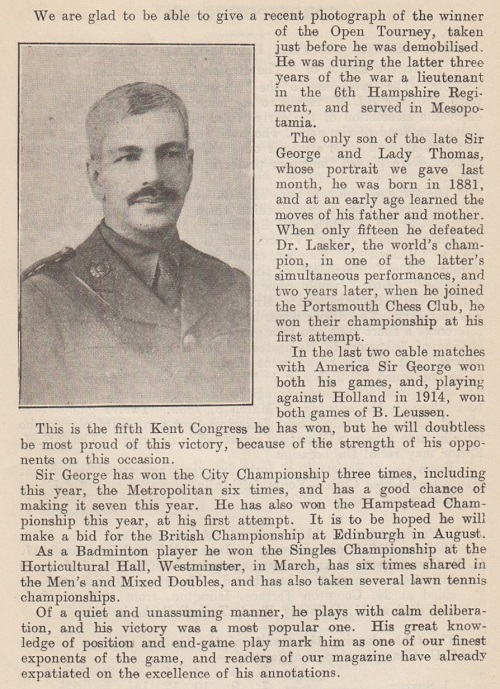
From page 99 of the April 1920 BCM:
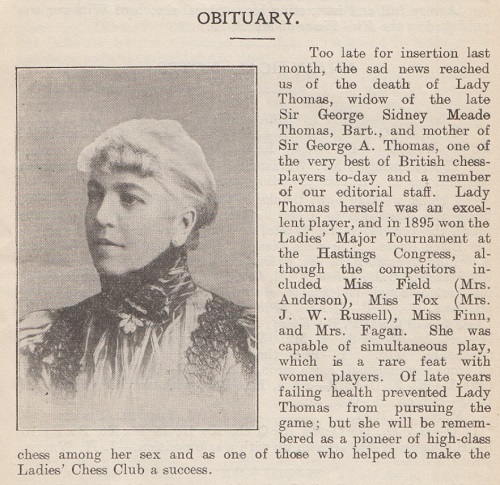
Further information about Lady Thomas was provided in C.N. 5690. Her husband died in 1918, and the National Portrait Gallery, London has a fine photograph of their son.
(9848)
Alper Efe Ataman (Izmir, Turkey) asks for information about Sir George Thomas’s early connection with Turkey.
The entry in Jeremy Gaige’s unpublished 1994 edition of Chess Personalia was slightly longer than the one in the 1987 McFarland book:
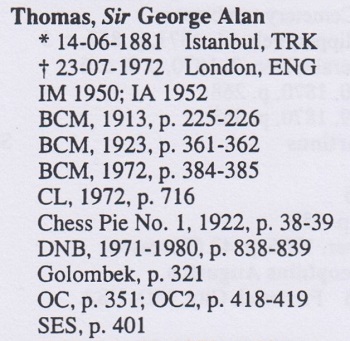
The above-mentioned BCM articles in 1913 and 1923 and the 1922 Chess Pie feature made no reference to his place of birth. Nor did the articles published in the BCM in 1920 (C.N. 9844) and Chess Review in 1935 (C.N.s 7088 and 9848).
The entries on Thomas in the Horton and Le Lionnais/Maget chess reference works (published in 1959 and 1967/1974 respectively) gave London as his place of birth, whereas the entry in Sunnucks’ encyclopaedia (first published in 1970) had the following:

That begs comparison with an article in CHESS entitled ‘In Memory of Sir George Thomas’ (December 1972 issue, page 70):
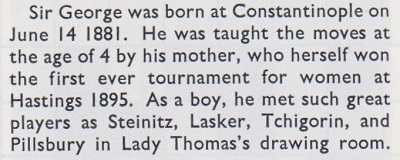
The obituary on pages 384-385 of the October 1972 BCM, by W. Ritson Morry, asserted unimpressively that Thomas was born in Constantinople on 14 June 1881, ‘the year of Zukertort’s memorable victory in the great London Tournament’.
Published in 1971, Chicco and Porreca’s Dizionario enciclopedico degli scacchi had been more specific, giving Thomas’s birth-place as Therapia (Tarabya), a district of Constantinople/Istanbul and a centre of British administration in Turkey. The information is thus consistent with the statement in the Oxford Dictionary of National Biography that Thomas ‘was born in the British consulate in Constantinople’.
Page 362 of the Hastings, 1895 tournament book recorded concerning Lady Thomas:
‘She lived for some years with her husband, Sir Geo. Thomas, Bart., at Constantinople, but now resides in this country, and is sometimes to be seen at the Ladies Chess Club, London.’
C.N. 5690 gave some extracts from an article about her in Woman’s Life, 18 January 1896, pages 255-256. Below is the full text:
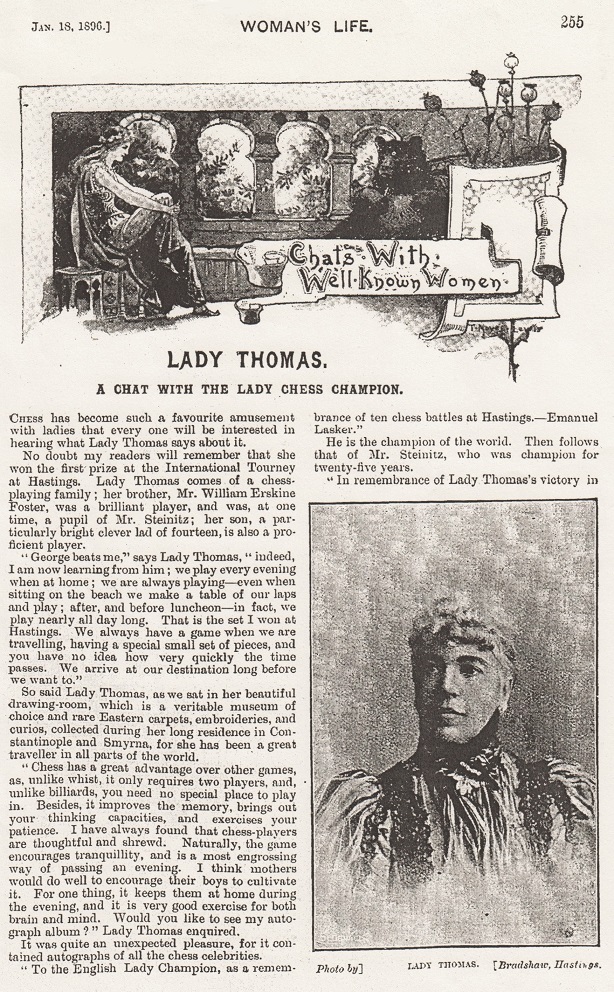
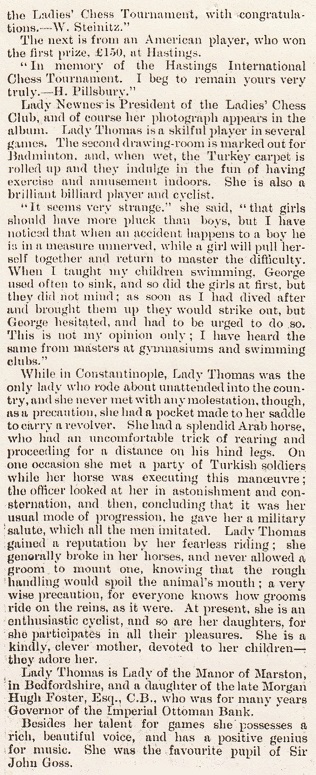
The entry for Sir George Sidney Meade Thomas on page 152 of volume two of John Venn’s Alumni Cantabrigienses:
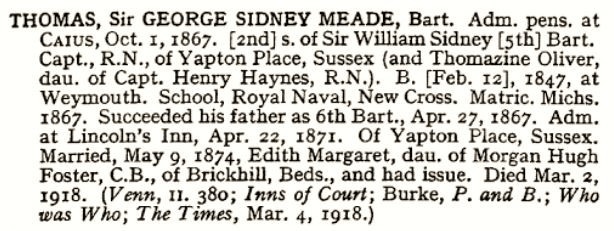
Lastly for now, a cutting from page 4 of the Cambridge Daily News, 6 March 1918:
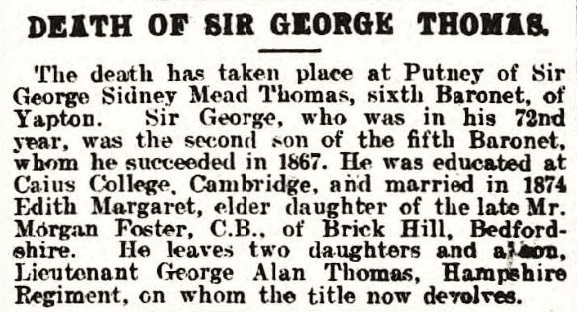
(10680)
C.N. 5690 referred to a record of Sir George Thomas’s chessplaying mother, Lady Edith Margaret Thomas (née Foster), having been born circa 1853 at The Bogue, St Elizabeth, Jamaica.
Jon D’Souza-Eva (Oxford, England) reports that now the FamilySearch webpage states ‘Birth about 1846, Hanover, German Empire’ and adds that she was christened in Hanover on 25 January 1846.
Concerning Lady Thomas, see too the photograph in Chess and Women (C.N. 3281).
(11930)
The article below by the ‘Badmaster’ is reproduced from page 25 of our publication Chess Characters (Geneva, 1984). It originally appeared in the August 1977 issue of Newsflash.
‘The bilious and impecunious Badmaster, glaring over last month’s Newsflash with a malevolent eye, was delighted to find that the price of Modern Chess Literature, and Books on the Openings in particular, seems to be coming under fire. For if the BM ever agreed to be interviewed on Television and was finally asked, “Looking back, Badmaster, over half a century of lost games, is there any particular factor which you feel has had the greatest influence on your disastrous career?”, he would reply in ringing tones: “Buying Books on the Openings”.
A particularly shameful instance of the BM being let down by these treacherous tomes occurred during the London Championship Tournament 1945. An awful morning had dawned when the official “Order of the Day” ran (inter alia) – “Round 6. Sir George Thomas (White) Badmaster (Black)”. Surmising (correctly) that his august opponent would open P-K4 and go for a quick win, the BM sat up most of the previous night with Modern Chess Openings (Griffith and White), selected the Petroff Defence, distended his brainbox with all 12 columns given, and arrived at the arena next day with the full cargo still on board. The result was that for the first eight moves the BM played with a precision which confounded the critics, but then Sir George (who had previously played like the orthodox gentleman that he was) suddenly revealed himself (in Marxist language) a deviationist of the basest stamp. In short, his ninth move was nowhere to be found. Deserted by MCO, the BM found himself in the same plight as David Balfour in Kidnapped when he ascended the tower in total darkness, only to find suddenly that “the stair had been carried no further” and that he was left to proceed on his own into the void. This he did, and perished about the 20th move. But the most infamous part of the story has yet to come. Of the two unworthy authors responsible for the BM’s downfall White (like Jacob Marley) had long been dead; but R.C. Griffith (a most sprightly “Scrooge”) was not only very much alive but actually a spectator at this very tournament. Just as the BM resigned, R.C.G., who was standing by, bestowed upon him a whimsical yet kindly smile, which plainly said: “Never mind, young man, you’ll know that variation another time”. He then went away beaming all over his face. But for his benevolent appearance and charming manner, the BM could have “felled him like a rotten tree”.’
(6046)
The following article by G.H. Diggle comes from page 71 of Chess Characters, having originally appeared in the August 1981 Newsflash:
‘Sir George Thomas, the centenary of whose birth was on 14 June, made his first début at the Tunbridge Wells Congress in 1902, where he tied in the “First Class” with R.P. Michell and G.E. Wainwright. He progressed steadily, winning the City of London Championship for the first of many times in 1913 and becoming British Champion in 1923. But (strangely at first sight) his chess strength increased if anything after he had reached middle age. There was a reason for this. Previously he had devoted his leisure to chess, badminton and lawn tennis. When anno domini began to reduce his prowess in the two active games (in both of which he was an “international”) he gave all his attention to chess, and thus culminated at an age when (in his case) he could still stand the physical strain of long tournament sessions. His greatest achievement was at the age of 53 when (having in 1934 again won the British Championship) he was equal first at Hastings, 1934-35 against a tremendous opposition, the scores being Thomas, Euwe and Flohr 6½ each, Capablanca (if you please) 5½ only, Botvinnik and Lilienthal 5 each. In a wonderful spurt Sir George defeated Capablanca in 53 moves, Botvinnik in 60, and Lilienthal in 30, though his win against the Cuban was a little overshadowed by Lilienthal, who also defeated him by a famous queen sacrifice. At the end of the penultimate round everyone eagerly hoped (and expected) to see Sir George end up a clear winner – with a score of 6½ he was half a point ahead of Dr Euwe and a full point or more clear of “the field” and he had only his old friend Michell (who had had an unsuccessful tournament) to meet in the last round. There can be no doubt that Michell would have liked to “go easy”, but such were the rigid principles of both players that he went all out for a win and got it. At the prize-giving Dr Euwe referred to “characteristic British sportsmanship” and Flohr “expressed a wonder whether any other country could have furnished such an example”.
The BM had the opportunity of observing Sir George in 1944-45 both at the West London and Lud-Eagle Clubs. He seemed rather a shy man, with a horror of being treated with anything like undue deference either as a chess master or as a Baronet. Once when the BM merely held a door open for him he almost panicked: “No no no. You first.” Over the board, he was the quietest of men, except on one solitary occasion. The London Championship tournament of October 1945 (the first in this country since the end of the War) had attracted the press. Scarcely had the opening moves in the first round been made when hooded cameramen with crouching stance and the evil mien of medieval executioners appeared from nowhere, encircled the combatants, and blazed away with their flashlights for a full minute. Just as the blitz seemed all over, and the torturers in full retreat, one of them turned on Sir George (presumably as the most distinguished competitor) and honoured him by “discharging a second barrel”. Whereupon the Baronet was distinctly heard to “use a big, big D” but, recovering immediately, he bestowed a sheepish grin on his opponent, and quietly “returned to his muttons”.’
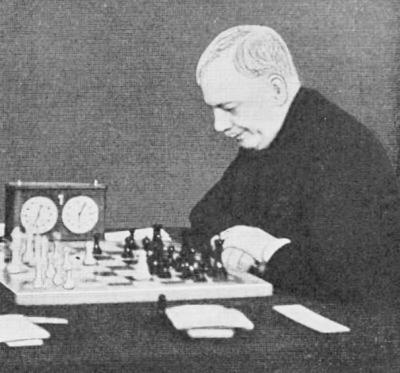
Sir George Thomas
(7775)
Regarding the above photograph Kari Tikkanen (Iisalmi, Finland) notes that it shows the game Koltanowski v Thomas in the Hastings, 1935-36 tournament.
We reproduced the picture from page 273 of CHESS, 7 July 1956, but page 236 of the magazine’s 14 February 1936 issue had more:
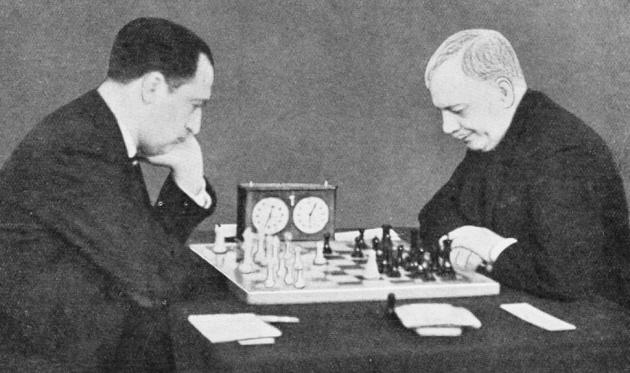
(7780)
The above-mentioned Koltanowski v Thomas game was played in January 1936, in the seventh round of Hastings, 1935-36, and it appeared on page 42 of Koltanowski’s book Torneo internacional de Hastings 1935-1936 (Barcelona, 1936).
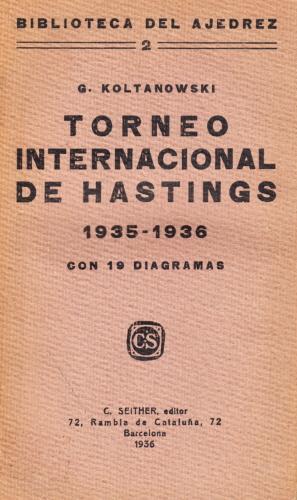
The Koltanowski touch is reflected in, for instance, the book’s references to Buenger, Friffith, Gensberg, Golombeck, Gross, Michel, Pire, Rubistein, Tartalkower, Vitmar, Womorsly, Wonorsly and even, on page 32, Koltanowki.
(7781)
Olimpiu G. Urcan has sent us, courtesy of the Hulton Archive, a photograph of Sir George Thomas in play against Tartakower, Hastings, 28 December 1935 (after 25 g5):
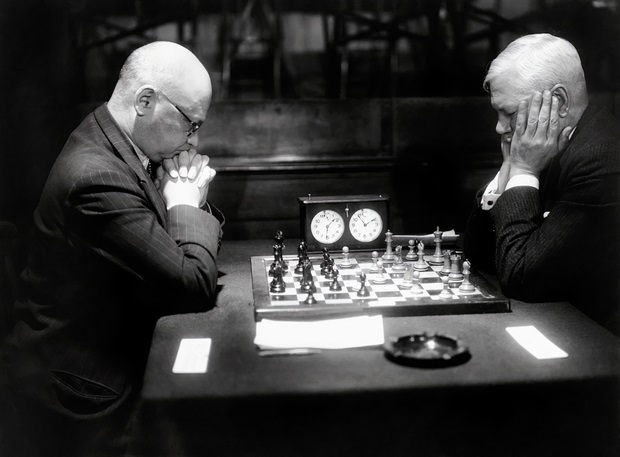
Many entries in the 2004 volumes of the Oxford Dictionary of National Biography conclude with a reference to ‘wealth at death’. We note, in particular, the following:
(6418)
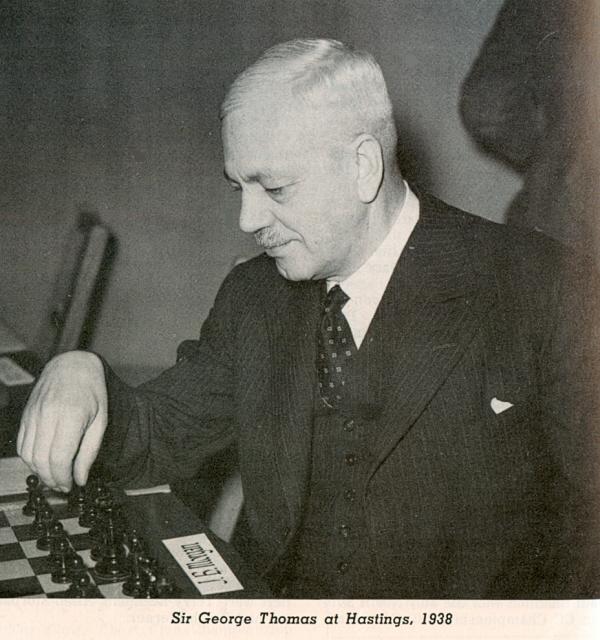
This fine photograph was published on page 716 of the November 1972 Chess Life & Review, to accompany an obituary of Sir George Thomas by T. Gordon Pollard.
Quiz question: is everything here straightforward?
(6988)
It is uncertain whether this photograph was taken at Hastings, 1937-38 or 1938-39. Nor is the significance of the name label (‘J.B. Morgan’?) apparent. Above all, of course, the board is incorrectly set (rotated by 90 degrees).
(7000)
Another good portrait of Sir George Thomas is on page 63 of Chess: Sixty Years On with Caissa and Friends by Alan Phillips (Yorklyn, 2003).
(6989)
From pages 116-117 of CHESS, 30 November 1970:
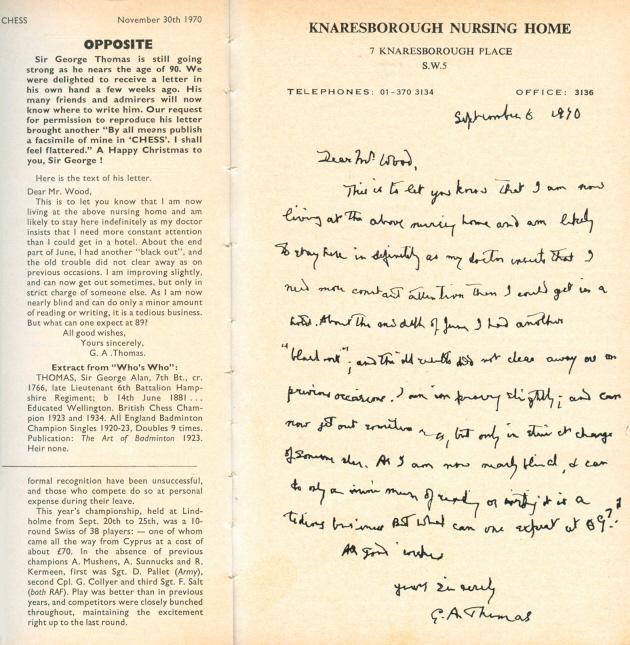
(7034)
C.N. 761 quoted a remark by Sir George Thomas on page 242 of the September 1951 BCM:
‘... It is my firm conviction that either Lasker or Capablanca at his best, and with no more modern equipment than he possessed at that time, could have given the odds of the latest technique to any player of today.’
(7128)
Our Where Did They Live? article has the following entries for Sir George Thomas:
Westaway, Godalming, Surrey, England (Ranneforths Schach-Kalender, 1930, page 79);
Flat 4, 2 Prince of Wales Terrace, London W8, England (Ranneforths Schachkalender, 1932, page 113);
73 North End House, Fitzjames Avenue, London W14, England (Ranneforths Schachkalender, 1938, page 79);
17 Fitzjames Avenue, London W14, England (Chess Pieces by Norman Knight, page viii).
From Olimpiu G. Urcan comes page 21 of the Illustrated London News, 5 January 1935:
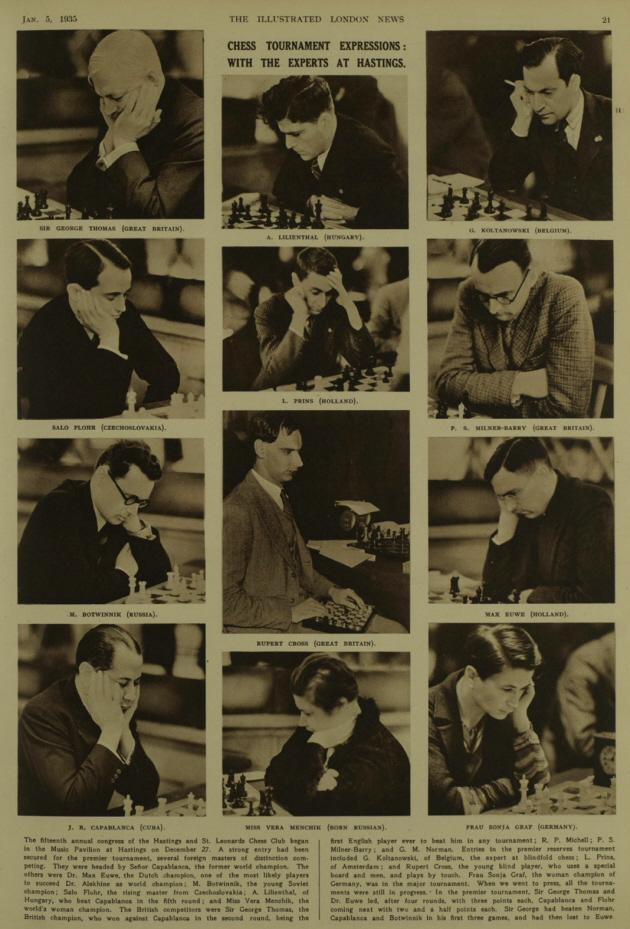
(7489)
Further to the recent material on Ernst Klein, a lightning game on page 219 of the July 1957 Chess Review may be noted:
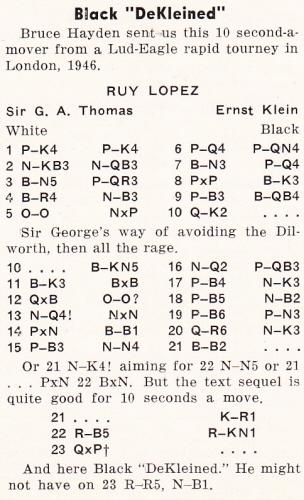
Sir George Thomas – Ernst Ludwig Klein
London, 1946
Ruy López
1 e4 e5 2 Nf3 Nc6 3 Bb5 a6 4 Ba4 Nf6 5 O-O Nxe4 6 d4 b5 7 Bb3 d5 8 dxe5 Be6 9 c3 Bc5 10 Qe2 Bg4 11 Be3 Bxe3 12 Qxe3 O-O 13 Nd4 Nxd4 14 cxd4 Bc8 15 f3 Ng5 16 Nd2 c6 17 f4 Ne6 18 f5 Nc7 19 f6 g6 20 Qh6 Ne6 21 Bc2 Kh8
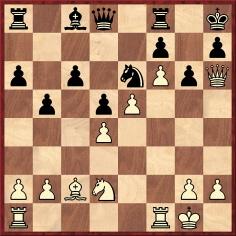
22 Rf5 Rg8 23 Qxh7+ Resigns.
Regarding Klein’s dispute at Margate in the late 1930s, we have added to Chess in the Courts a paragraph which appeared on page 269 of the 14 April 1938 CHESS under the heading ‘Klein’s “Honour Vindicated”’:
‘Ernst Klein has withdrawn his libel action against Alekhine, Miss Menchik, Prins and a group of other masters, having obtained an apology, with indemnification for costs. He states that his “honour has now been vindicated”.’
Can other press reports on the affair be traced?
(7732)
Bruce Hayden also supplied the Thomas v Klein miniature to Assiac for publication. See pages 51-52 of Assiac’s book The Delights of Chess (London, 1960), which stated that ‘the game was played at “lightning speed” (in less than ten minutes)’.
(7797)
A photograph on page 67 of The Anglo-Soviet Radio Chess Match by E. Klein and W. Winter (London, 1947):
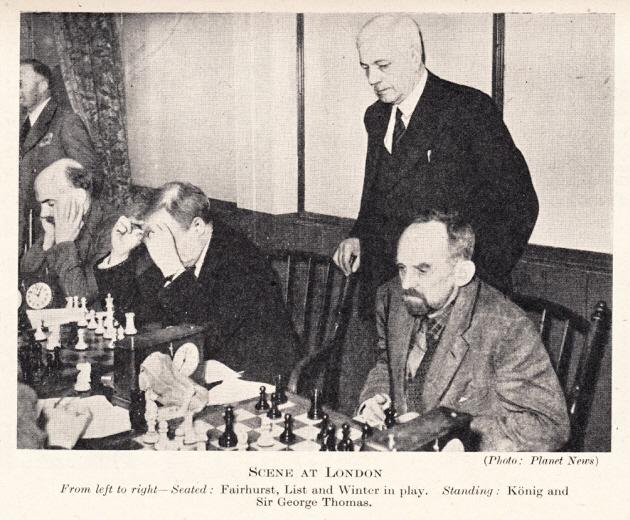
(7787)
Our archives include two score-books in which A.G. [Andrew] Laing recorded his games in the 1930s and 40s. His opponents included Vera Menchik, Jacques Mieses and Sir George Thomas, and an example follows, from a simultaneous display:
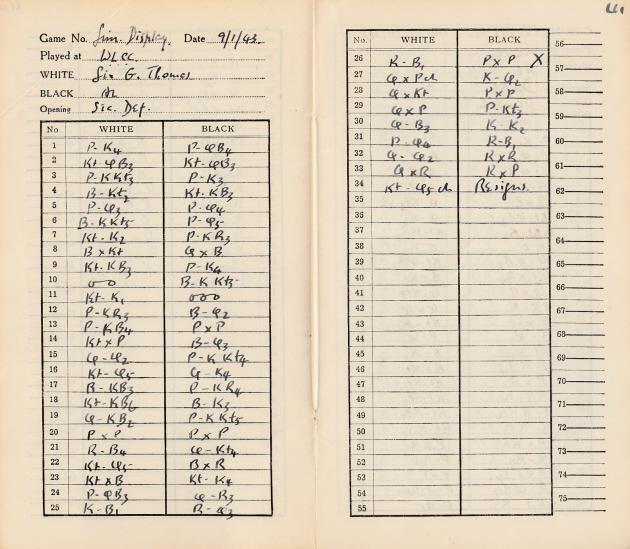
Sir George Thomas – A.G. Laing
London, 9 January 1943
Sicilian Defence
1 e4 c5 2 Nc3 Nc6 3 g3 e6 4 Bg2 Nf6 5 d3 d5 6 Bg5 d4 7 Nce2 h6 8 Bxf6 Qxf6 9 Nf3 e5 10 O-O Bg4 11 Ne1 O-O-O 12 h3 Bd7 13 f4 exf4 14 Nxf4 Bd6 15 Qd2 g5 16 Nd5 Qe5 17 Rf3 h5 18 Nf6 Be6 19 Qf2 g4 20 hxg4 hxg4 21 Rf4 Qg5
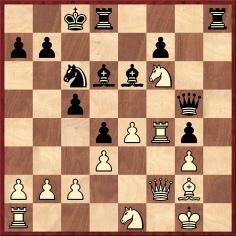
22 Nd5 Bxf4 23 Nxf4 Ne5 24 c3 Qh6 25 Kf1 Rd6 26 Rc1 dxc3 27 Qxc5+ Kd7 28 Qxe5 cxb2 29 Qxb2 b6 30 Qc3 Ke7 31 d4 Rc8 32 Qd2 Rxc1 33 Qxc1 Rxd4 34 Nd5+ Resigns.
From page 31 of the February 1943 BCM:
‘Sir George Thomas played 21 members of the West London Chess Club on 9 January, at 23 Stratford Road, N8.’
(8728)
Olimpiu G. Urcan offers the cuttings presented below:
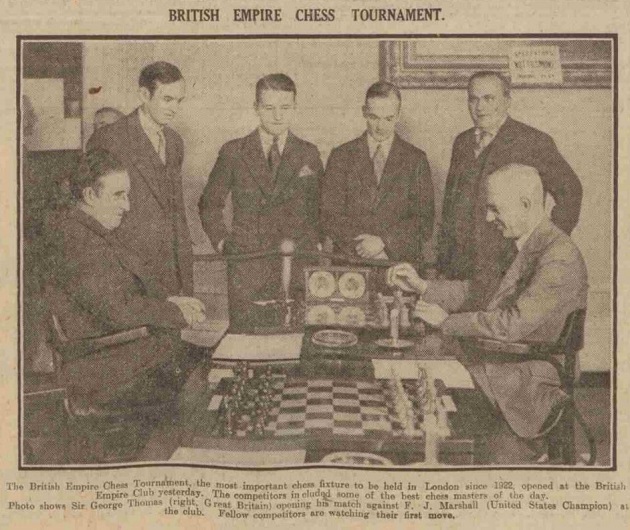
Dundee Evening Telegraph, 11 October 1927, page 1.
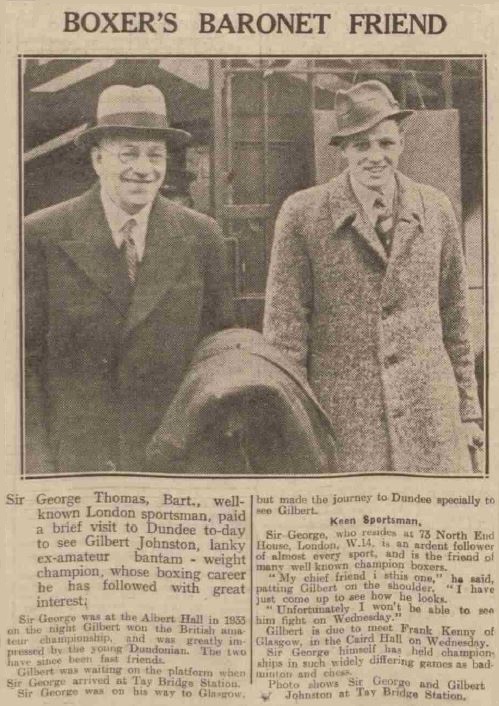
Dundee Evening Telegraph, 20 January 1938, page 1.
(8960)
Dominique Thimognier (Fondettes, France) has found this photograph on page 8 of the Czech publication Pestrý týden, 27 April 1929:
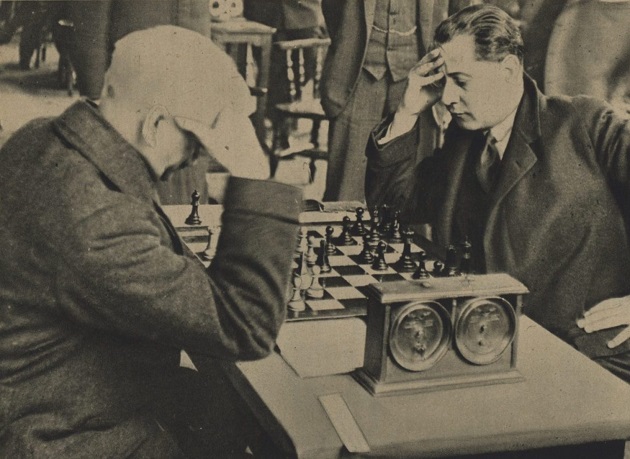
(9021)
See also C.N. 10302 below.
Dan Scoones (Port Coquitlam, BC, Canada) sends the back-cover of the 10/1972 issue of Shakhmaty Riga and draws attention to position IV:
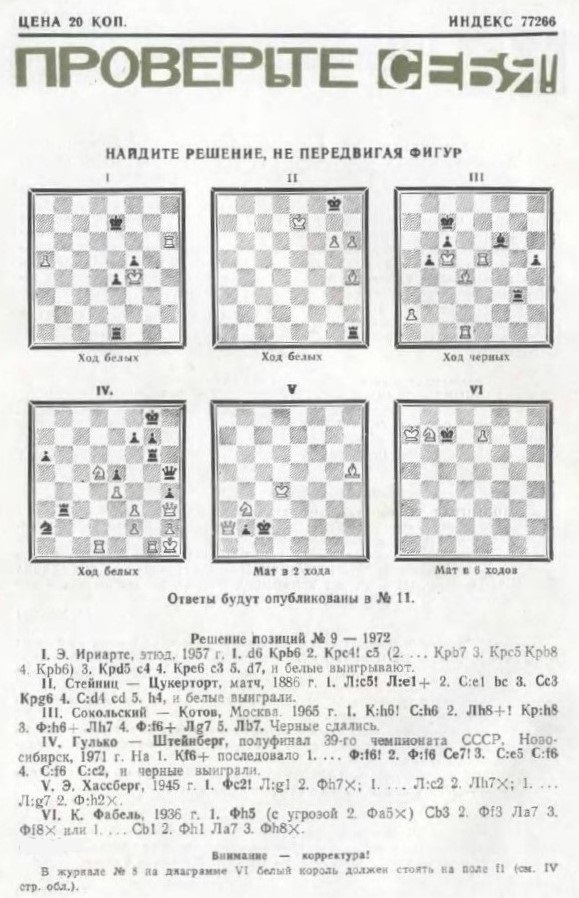
The solution on the back cover of the 11/1972 issue was:

Our correspondent found the same position on page 243 of the Encyclopaedia of Chess Middlegames (Belgrade, 1980), the solution being given (with no mention of the alternative line 1 Ne7+ Kh7 2 Nxg6) on page 249:
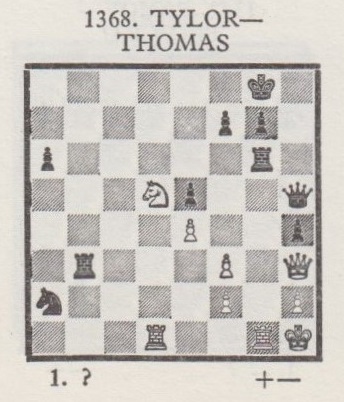
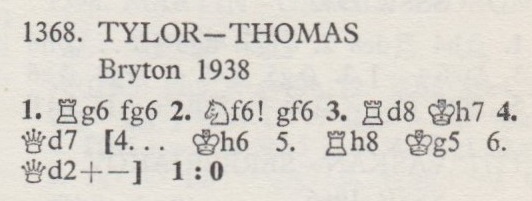
In Copying we commented regarding The Big Book of Combinations by Eric Schiller (San Francisco, 1994):
‘Another 1938 game, on page 249 of the Encyclopaedia, was “Tylor – Thomas Bryton 1938”. It may seem obvious that “Bryton” should read Brighton, but it was not obvious enough for Schiller; on page 36 he too uses the spelling “Bryton”, adding for good measure an original mistake of his own by changing Tylor to “Tyler”.’
Mr Scoones found the game-score in a database, which indicated that the above diagrams are wrong. The black king was on h8, and there is thus no alternative solution with Ne7+:
1 e4 e5 2 Nf3 Nc6 3 Nc3 Nf6 4 Bb5 Bb4 5 O-O O-O 6 d3 d6 7 Ne2 a6 8 Bxc6 bxc6 9 Ng3 Ne8 10 d4 Bg4 11 c3 Ba5 12 dxe5 Bxf3 13 gxf3 dxe5 14 Qa4 Bb6 15 Qxc6 Nd6 16 Be3 Rb8 17 b3 Qf6 18 Rad1 h5 19 Bxb6 Rxb6 20 Qxc7 Nb5 21 Qd7 h4 22 Nf5 Nxc3 23 Rd3 Nxa2 24 Ne7+ Kh8 25 Nd5 Qg5+ 26 Kh1 Rg6 27 Qh3 Rb8 28 Rdd1 Qh5 29 Rg1 Rxb3
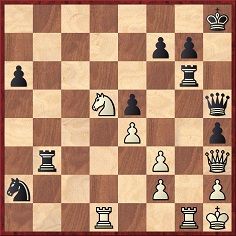
30 Rxg6 fxg6 31 Nf6 gxf6 32 Rd8+ Kg7 33 Qd7+ Kh6 34 Rh8+ Kg5 35 Qd2+ Resigns.
We have checked contemporary sources and can report that the database version is accurate. The BCM (September 1938, page 410) gave only the conclusion of the game, with the black king correctly on h8, but the full score was published on page 12 of The Times, 11 August 1938, having been played in the third round of the British championship the previous day:
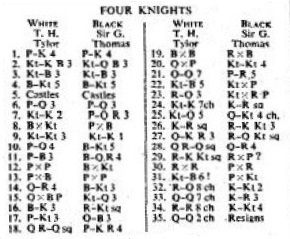
The score is confirmed by The Scotsman, 13 August 1938, page 18.
(9092)
From our Chess photographs in the Daily Mirror feature article:
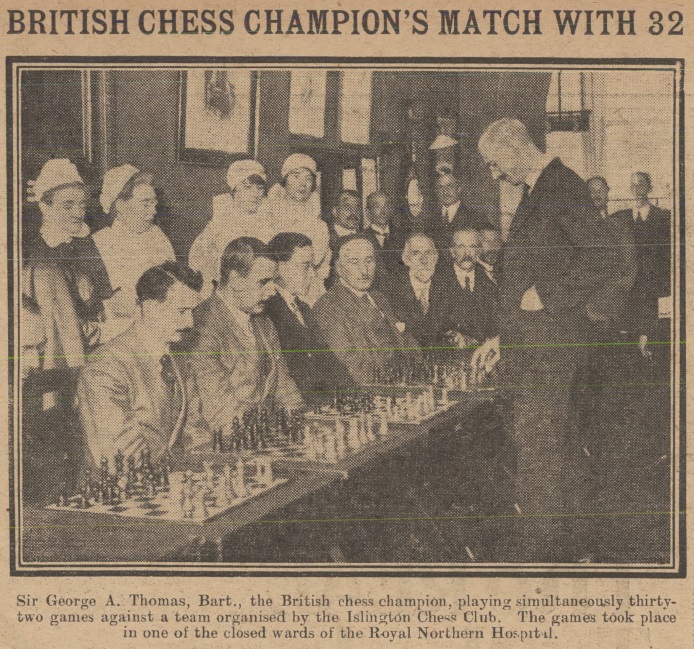
29 October 1923, page 5
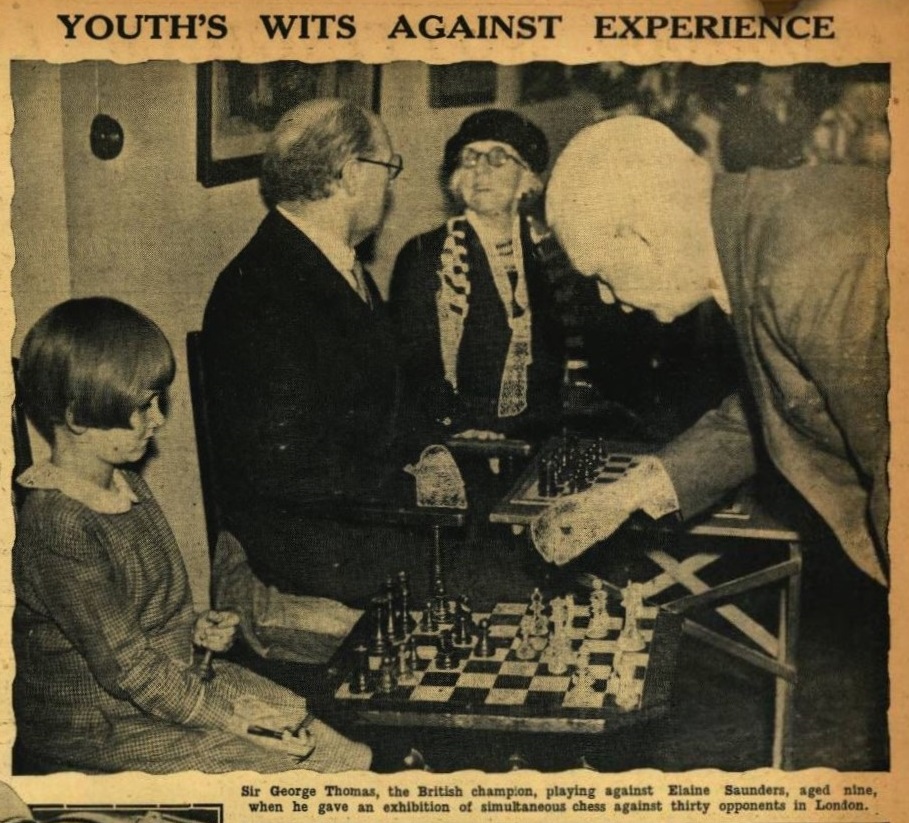
23 October 1934, page 19 (See too C.N. 9238.)
Olimpiu G. Urcan contributes a further photograph of Sir George Thomas in play against Elaine Saunders, courtesy of the Hulton Archive:
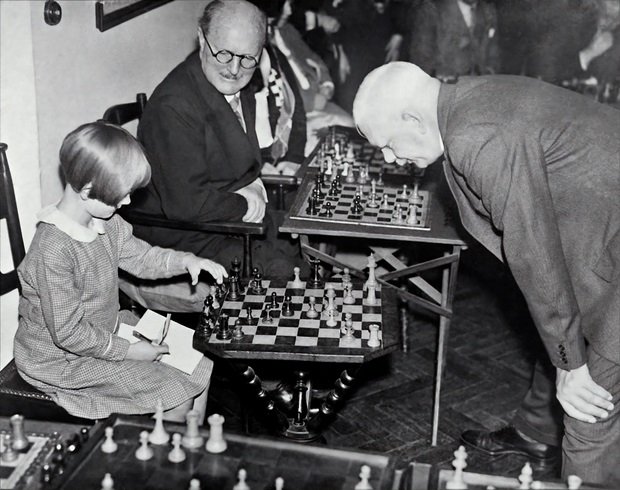
Chess photographs in The Graphic found by Olimpiu G. Urcan include the following, with background notes by us:
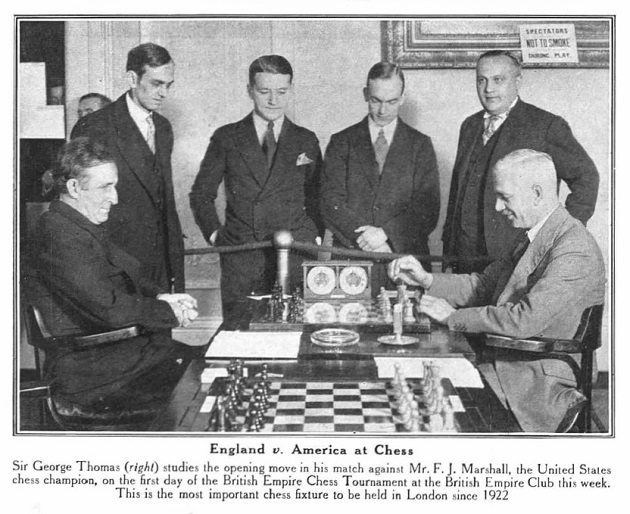
15 October 1927, page 92
A slightly different version of this photograph exists, and page 202 of A History of Chess by Harry Golombek (London, 1976) had another shot, taken from the opposite direction and showing a cameraman.
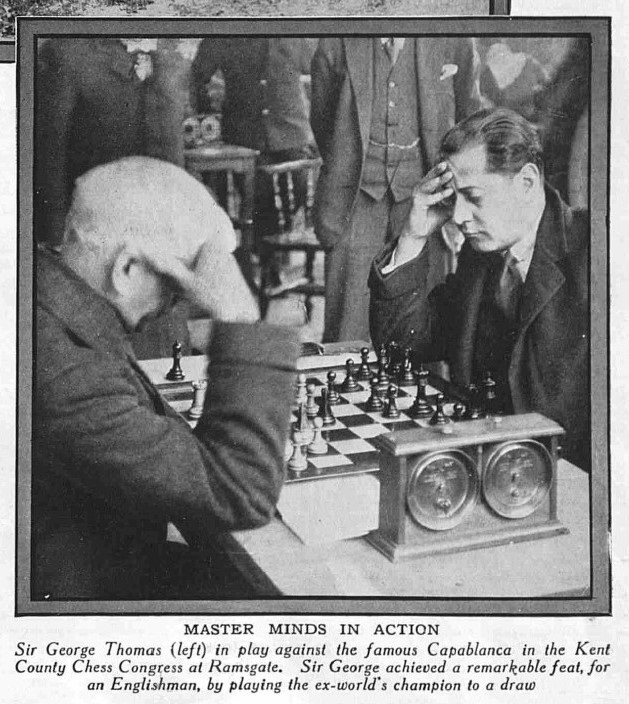
13 April 1929, page 63
A different version of this photograph was shown in C.N. 9021
above.
(10302)
Olimpiu G. Urcan has provided chess pictures published in the Illustrated Sporting and Dramatic News:

29 September 1923, page 683
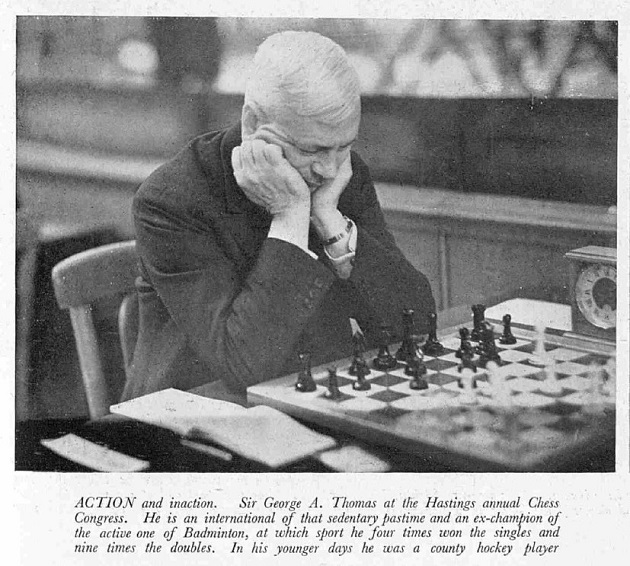
6 January 1934, page 41
(10307)
Page 69 of the American Chess World, March 1901:
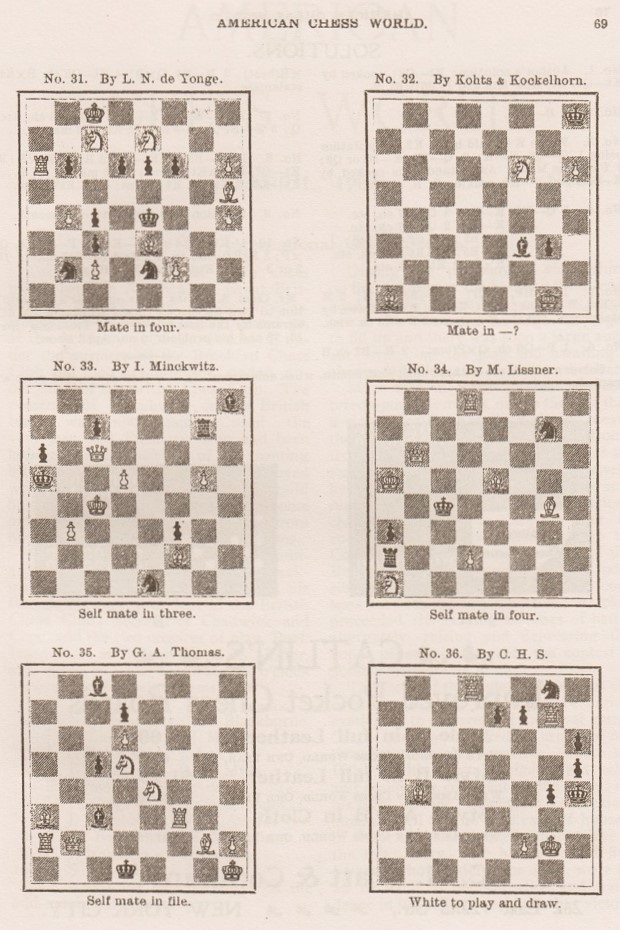
Page 94 of the April 1901 issue had a correction to problem 36 (the rook on g7 should be black), but it is problem 35, an intricate self-mate in five, that is of particular interest. Was it by George Alan Thomas?
The dearth of compositions by him was mentioned on page 32 of Leonard Barden’s Chess Puzzle Book (London, 1977), a collection of Evening Standard columns:
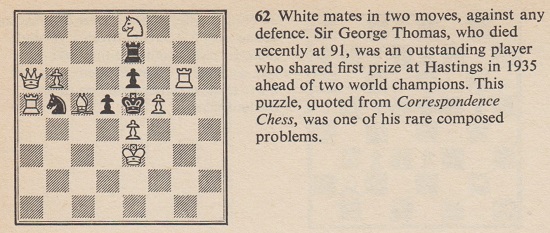
The problem’s appearance in Correspondence Chess, Autumn 1972, page 324, is shown below, courtesy of the Cleveland Public Library:
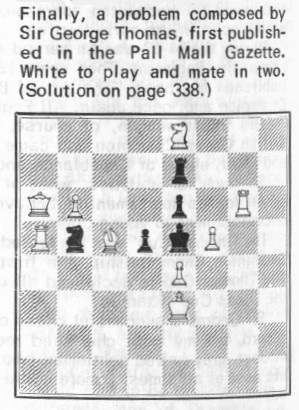
From page 9 of the Pall Mall Gazette, 15 March 1897:
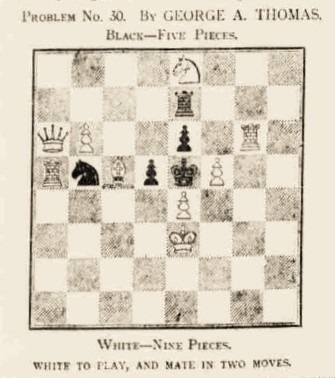
The solution was published on page 9 of the 22 March 1897 edition.
The article ‘A Great British Sportsman’ by Mrs Jean Rogers on pages 323-324 of the above-mentioned issue of Correspondence Chess included a postal game which he won against W.J., with notes by Gunsberg from the Penny Illustrated Paper, 13 November 1897:
1 d4 f5 2 c4 Nf6 3 Nc3 e6 4 a3 c6 5 Bg5 Be7 6 e3 a6 7 Nf3 O-O 8 Bd3 Ne8 9 Bf4 d6 10 h3 Nd7 11 Qc2 Rf7 12 O-O-O Nf8 13 g4 Ng6 14 Ne2 Bd7 15 gxf5 exf5 16 Rdg1 Nxf4 17 Nxf4 Bh4 18 c5 Bf6 19 h4 d5 20 h5 Qc7 21 h6 g6
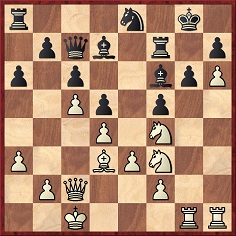
22 Bxf5 Bxf5 23 Qxf5 Bxd4 24 Rxg6+ Kh8 25 Rhg1 Bxb2+ 26 Kxb2 hxg6 27 Nxg6+ Resigns.
We have not seen that issue of the Penny Illustrated Paper but can show another early game won by Thomas, aged 15, against A.C. Jackman, from page 9 of the Pall Mall Gazette, 8 February 1897:
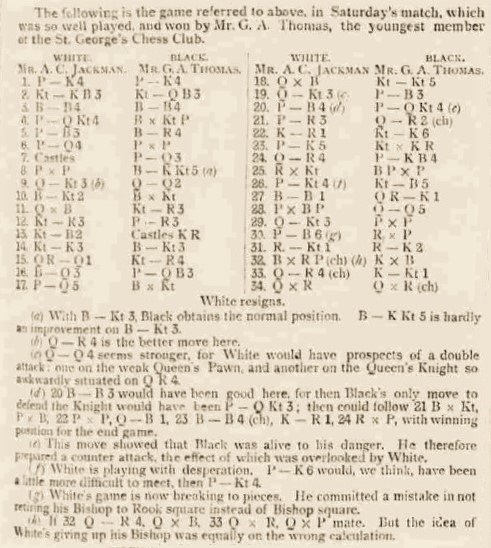
The game was played in an 11-board match on 6 February 1897 at the St George’s Chess Club in London between that Club and a North London team.
1 e4 e5 2 Nf3 Nc6 3 Bc4 Bc5 4 b4 Bxb4 5 c3 Ba5 6 d4 exd4 7 O-O d6 8 cxd4 Bg4 9 Qb3 Qd7 10 Bb2 Bxf3 11 Qxf3 Nh6 12 Na3 a6 13 Nc2 O-O 14 Ne3 Bb6 15 Rad1 Na5 16 Bd3 c6 17 d5 Bxe3 18 Qxe3 Ng4 19 Qg3 f6 20 f4
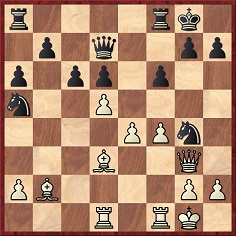
20...b5 21 h3 Qa7+ 22 Kh1 Ne3 23 e5 Nxf1 24 Qh4 f5 25 Rxf1 cxd5 26 g4 Nc4 27 Bc1 Rae8 28 gxf5 Qd4 29 Qg3 dxe5 30 f6 Rxf6 31 Rg1 Re7 32 Bxh7+ Kxh7 33 Qh4+ Kg8 34 Qxf6 Qxg1+ 35 White resigns.
(10329)
The request for Gunsberg’s column in the Penny Illustrated Paper, 13 November 1897 has been answered by Roger Watson (Dewsbury, England). It was on page 309:

(10334)
Addition on 10 January 2024:
Michael McDowell (Westcliff-on-sea) writes:
‘WinChloe gives the source of the S#5 by George Thomas as 1259, the BCM, January 1897. Strangely, the #2 is not in any of the databases.’
The self-mate (diagram repeated below) is on page 40 of the January 1897 BCM (‘By Geo. A. Thomas, Southsea’), and the solution appeared on page 123 of the March 1897 issue.

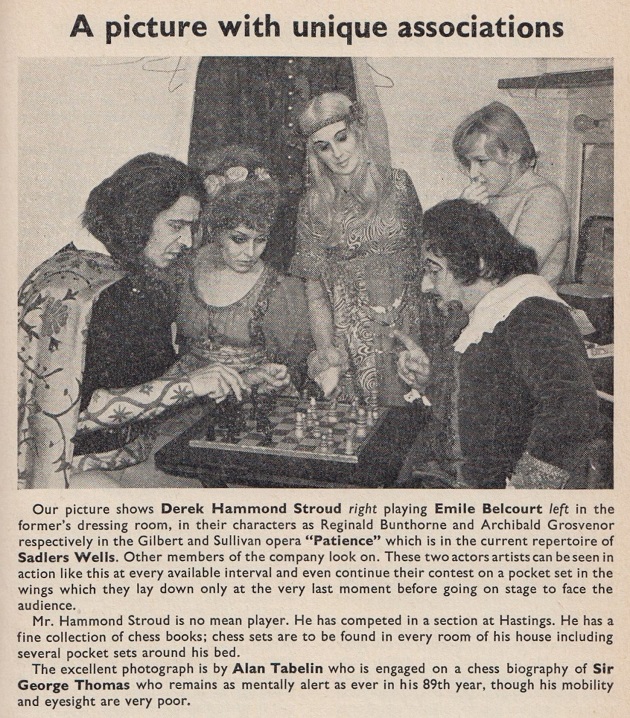
Source: CHESS, Easter 1970, page 225.
Is any information available on Alan Tabelin’s planned book on Sir George Thomas, mentioned in the final paragraph?
(10247)
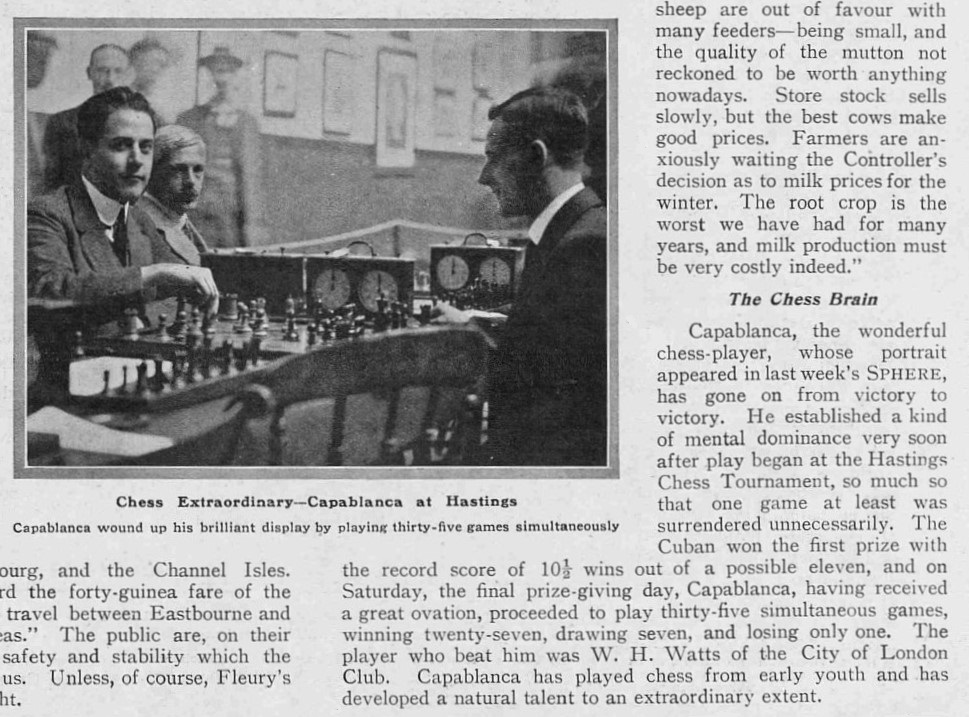
The Sphere, 30 August 1919, page 191
From Olimpiu G. Urcan:
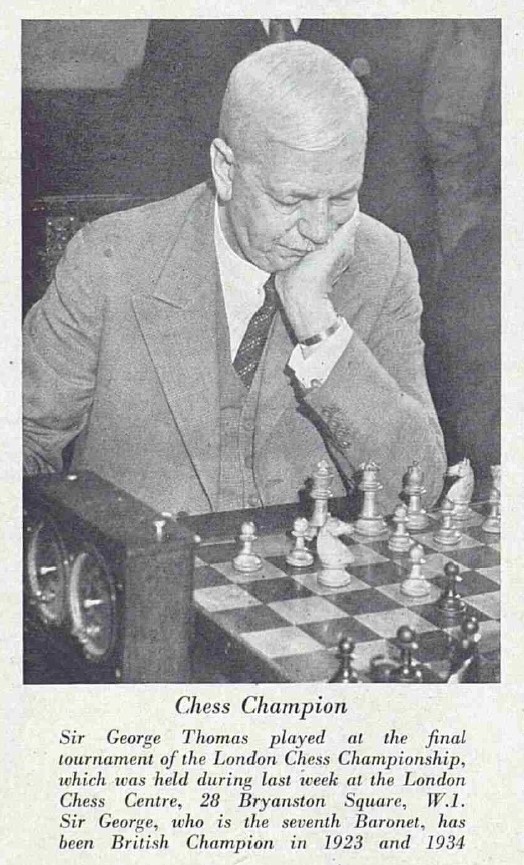
The Tatler and Bystander, 24 October 1945, page 98.
(10368)
A project announced on page 8 of the (London) Times, 4 January 1939:
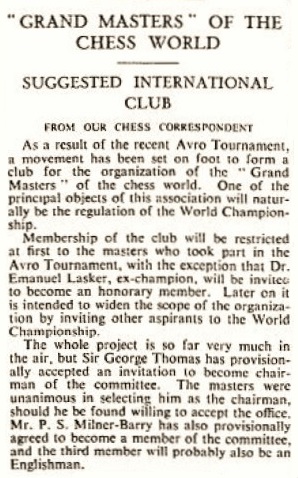
The report was reproduced on page 167 of the January 1939 CHESS, as mentioned in C.N. 1590:
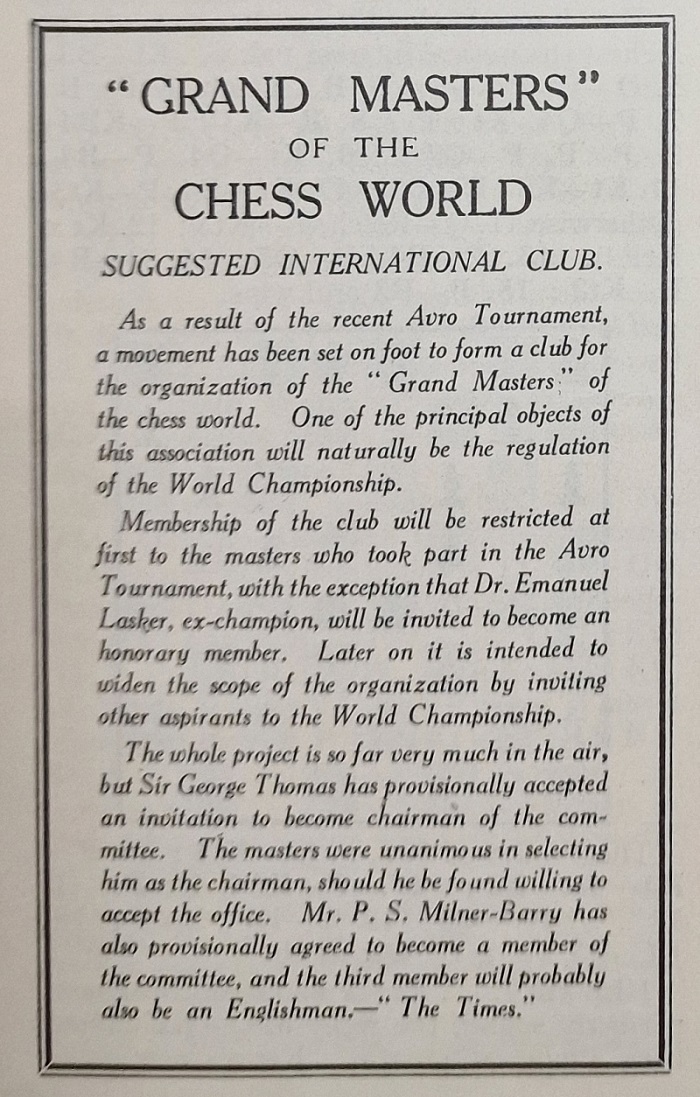
Page 8 of the 16 January 1939 edition of the Times had a brief follow-up note about the Anglocentric initiative (on which further information is sought):
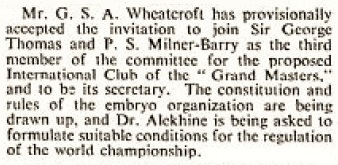
(10695)
See Chess Grandmasters.
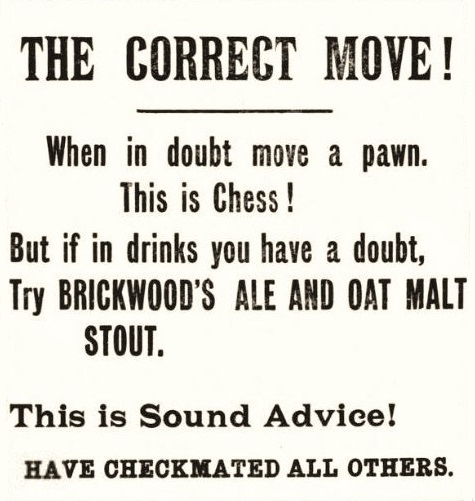
Portsmouth Evening News, 17 September 1910, page 1
Earlier that year, a more familiar version of the ‘when in doubt ...’ phrase had appeared in note (g) to a game between F.D. Yates and G.A. Thomas on page 15 of the Hereford Times, 16 April 1910:
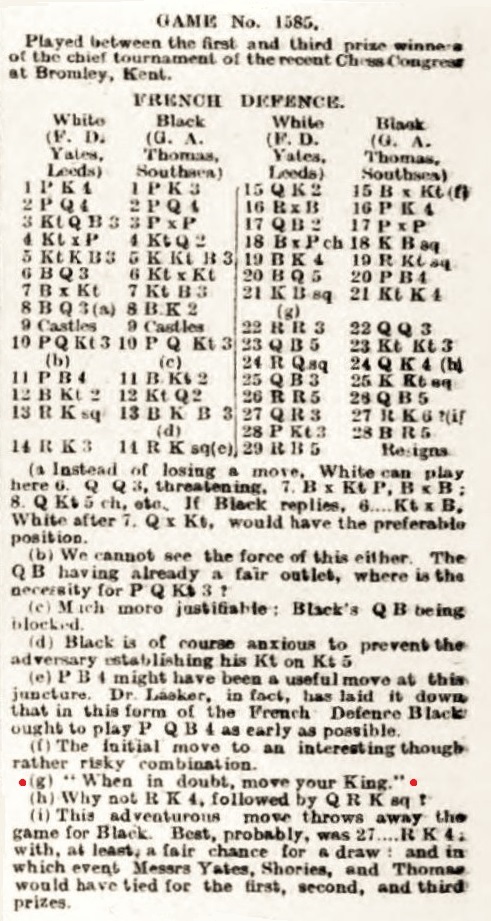
1 e4 e6 2 d4 d5 3 Nc3 dxe4 4 Nxe4 Nd7 5 Nf3 Ngf6 6 Bd3 Nxe4 7 Bxe4 Nf6 8 Bd3 Be7 9 O-O O-O 10 b3 b6 11 c4 Bb7 12 Bb2 Nd7 13 Re1 Bf6 14 Re3 Re8 15 Qe2 Bxf3 16 Rxf3 e5 17 Qc2 exd4 18 Bxh7+ Kf8 19 Be4 Rb8 20 Bd5 c5 21 Kf1 Ne5 22 Rh3 Qd6 23 Qf5 Ng6 24 Rd1 Qe5 25 Qf3 Kg8 26 Rh5 Qf4 27 Qh3 Re3 28 g3 Bh4
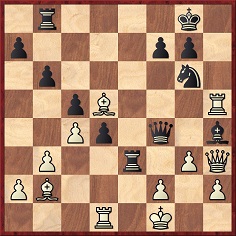
29 Rf5 Resigns.
(11112)
Page 120 of Womanhood, 1904 had a correspondence game between George Alan Thomas and Ronald Cadell Macdonald:
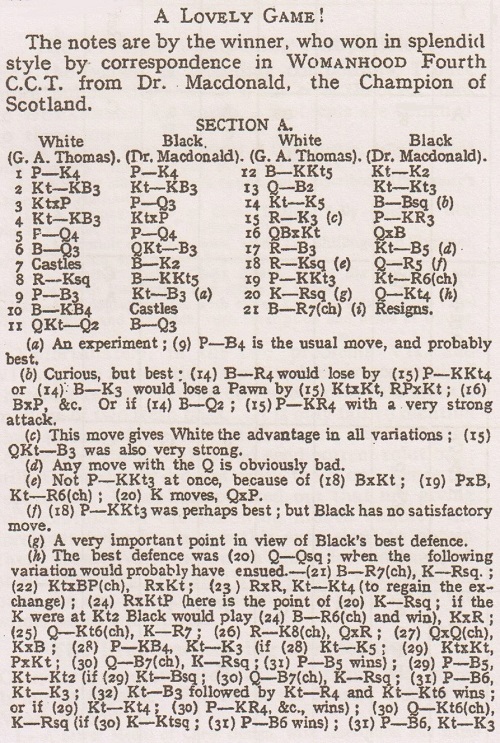

1 e4 e5 2 Nf3 Nf6 3 Nxe5 d6 4 Nf3 Nxe4 5 d4 d5 6 Bd3 Nc6 7 O-O Be7 8 Re1 Bg4 9 c3 Nf6 10 Bf4 O-O 11 Nbd2 Bd6 12 Bg5 Ne7 13 Qc2 Ng6 14 Ne5 Bc8 15 Re3 h6 16 Bxf6 Qxf6 17 Rf3 Nf4
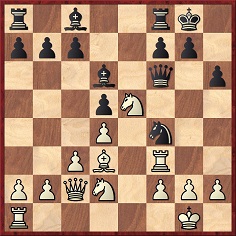
18 Re1 Qh4 19 g3 Nh3+ 20 Kh1 Qg5 21 Bh7+ Resigns.
(11158)
From an article by Jeremy Gaige, ‘The Ethics of Chess’, on page 106 of Chess Review, April 1961:
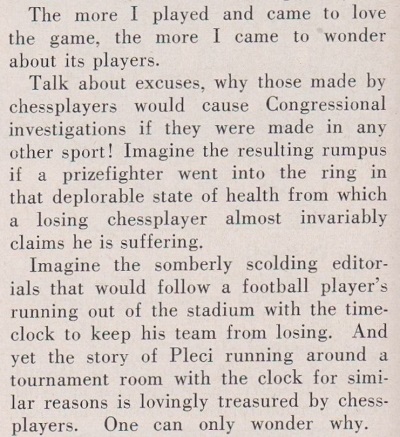
The story is related on, for instance, pages 82-83 of The Chess Scene by David Levy and Stewart Reuben (London, 1974):
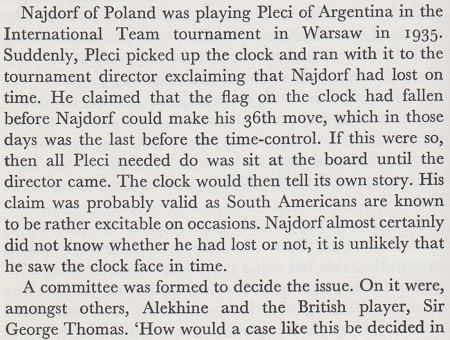

No source was given, naturally, but the ease with which anyone can fill space with such stuff is demonstrated by this extract from a ‘Round the Chess World’ article by G. Koltanowski on page 77 of CHESS, 14 October 1935:
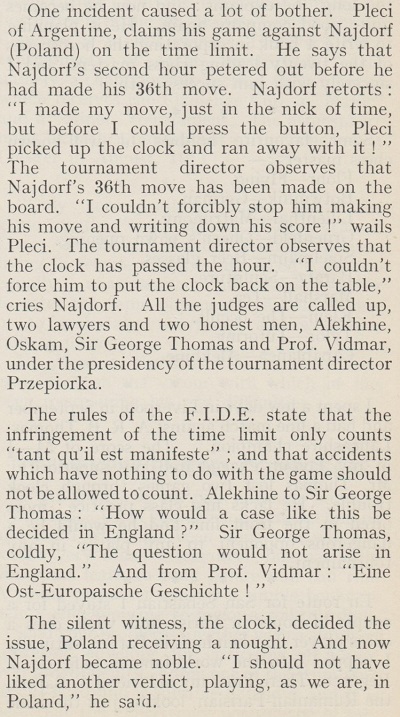
The episode was also related on page 18 of Najdorf: Life and Games by T. Lissowski and A. Mikhalchishin (London, 2005). The conclusion:
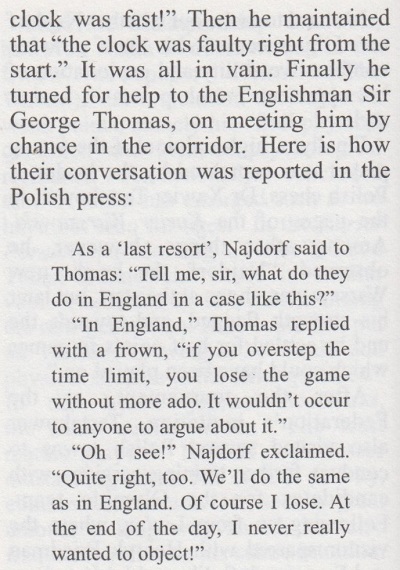
On the strict basis of authoritative accounts, and ideally with the game-score, how can the incident best be summarized in a brief paragraph?
(11395)
On the topic of Luck in Chess, below is an extract from pages 82-83 of The Pleasures of Chess by Assiac (New York, 1952):
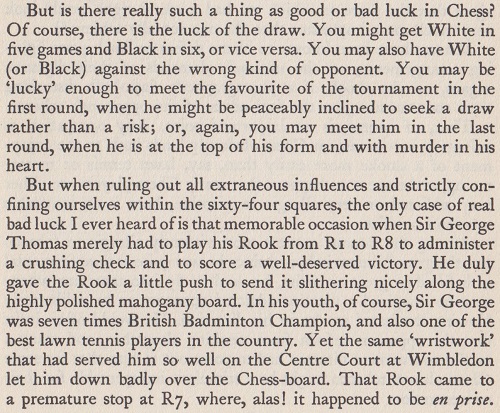
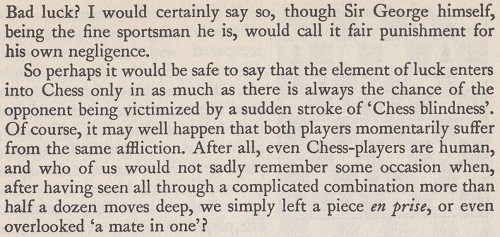
Wanted: details of the ‘memorable’ occasion involving Sir George Thomas.
(11515)
The earliest over-the-board game by Leonard Barden that we recall seeing was played in the British Boys’ Championship in Hastings in April 1946. From page 141 of the May 1946 BCM:
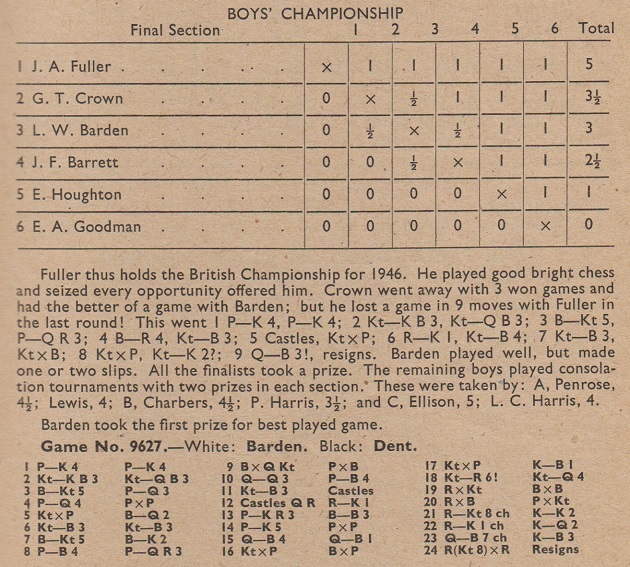
1 e4 e5 2 Nf3 Nc6 3 Bb5 d6 4 d4 exd4 5 Nxd4 Bd7 6 Nc3 Nf6 7 Bg5 Be7 8 f4 a6 9 Bxc6 bxc6 10 Qd3 c5 11 Nf3 O-O 12 O-O-O Re8 13 h3 Bc6 14 e5 dxe5 15 Qc4 Qc8 16 Nxe5 Bxg2 17 Nxf7 Kf8
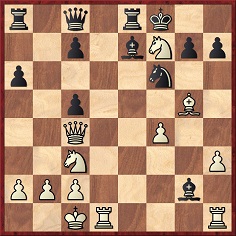
18 Nh6 Nd5 19 Rxd5 Bxg5 20 Rxg5 gxh6 21 Rg8+ Ke7 22 Re1+ Kd7 23 Qf7+ Kc6 24 Rgxe8 Resigns.
Page 168 of CHESS, May 1946 mentioned that the prize was given by Sir George Thomas. He was in the group photograph accompanying a report by A.J. Mackenzie on page 1 of the Hastings and St Leonards Observer, 20 April 1946. Can a better copy be found?
We sent a preview of the present item to Leonard Barden, who has commented:
‘I have no memory of that victory, though I recognize the opponent’s name. On the other hand, I have a strong negative memory of playing Fuller, where I chose the Wing Gambit and left my a5 rook en prise to a black knight quite early on, and a strong positive memory against Crown, where I stood slightly worse throughout as Black in a Queen’s Indian Defence but defended well to draw a difficult rook ending.
Sir George Thomas was an active spectator at major junior events in London and Hastings at that time and was very alert to pointing out tactical opportunities that the players had missed – including one of my own against Barrett at Hastings which could have enabled me to share second place.’
(11642)

Source: The Globe, 14 January 1911, page 8.
Though absent from various databases, the game is not altogether ‘unknown’. It is on pages 117-118 of The Complete Games of Oldrich Duras by Jan Kalendovský (Nottingham, 1997), which took the score from Časopis českých šachistů, 1911, page 22:
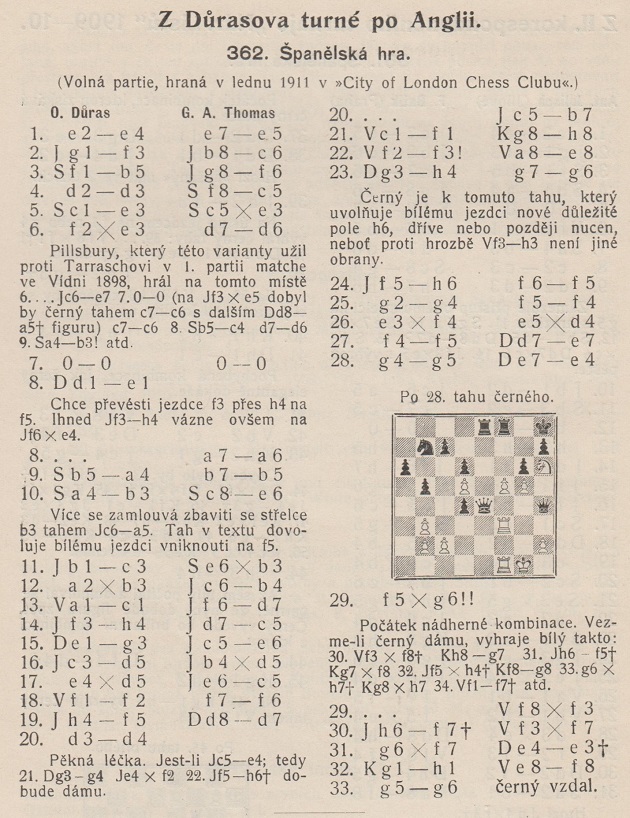
1 e4 e5 2 Nf3 Nc6 3 Bb5 Nf6 4 d3 Bc5 5 Be3 Bxe3 6 fxe3 d6 7 O-O O-O 8 Qe1 a6 9 Bc4 b5 10 Bb3 Be6 11 Nc3 Bxb3 12 axb3 Nb4 13 Rc1 Nd7 14 Nh4 Nc5 15 Qg3 Ne6 16 Nd5 Nxd5 17 exd5 Nc5 18 Rf2 f6 19 Nf5 Qd7
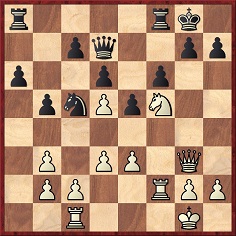
20 d4 Nb7 21 Rcf1 Kh8 22 Rf3 Rae8 23 Qh4 g6 24 Nh6 f5 25 g4 f4 26 exf4 exd4 27 f5 Qe7 28 g5 Qe4 29 fxg6 Rxf3 30 Nf7+ Rxf7 31 gxf7 Qe3+ 32 Kh1 Rf8 33 g6 Resigns.
(11668)
See also two feature articles: Chaos in a Miniature (on Edward Lasker v George Thomas, London, 1912) and Capablanca v Thomas, Hastings, 1919.
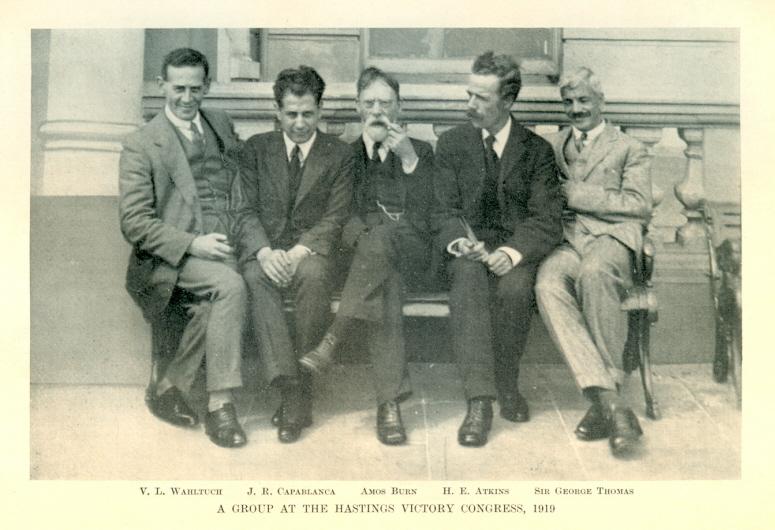
From A Century of British Chess by P.W. Sergeant (London, 1934)
Some portraits of Sir George Thomas may be acquired by contacting gettyimages.
Addition on 9 January 2024:
In early January 2006 we acquired a copy of The Chess Games of Sir George Alan Thomas by Roger Leslie Paige, a 549-page self-publication, but did not find it dependable.
From page 161 of The Unknown Capablanca by David Hooper and Dale Brandreth (London, 1975):
‘One is reminded of a remark made by Sir George Thomas, “Against Alekhine”, he said, “you never knew what to expect; against Capablanca you knew what to expect, but you couldn’t prevent it!”’
From page 77 of Capablanca’s Best Chess Endings by Irving Chernev (Oxford, 1978):
‘Capablanca’s clear-cut play in this ending calls to mind a comment by Sir George Thomas, “Against Alekhine you never knew what to expect; against Capablanca you knew what to expect, but you couldn’t prevent it!”’
(11976)
No pre-1975 source for this remark has yet been found.
John Saunders (Kingston upon Thames, England) submits this report from page 9 of the Morning Post, 22 June 1895:
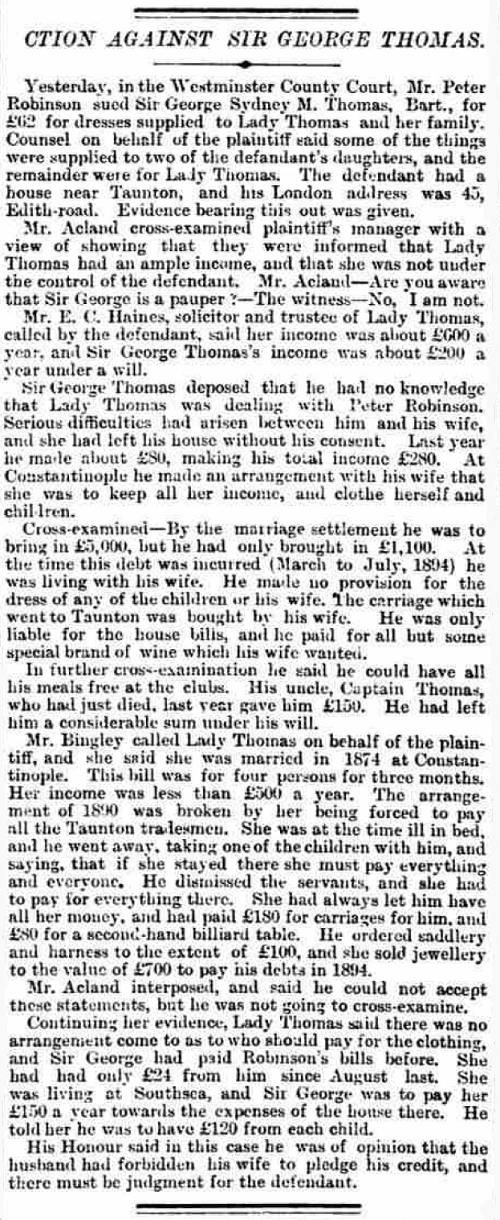
Our correspondent is the Webmaster of BritBase – British Chess Game Archive.
(11990)
Addition on 18 February 2025:
Olimpiu G. Urcan has forwarded an article by Sir George Thomas, ‘Temperament in Games’, from page 6 of The Evening News (London), 18 July 1927:
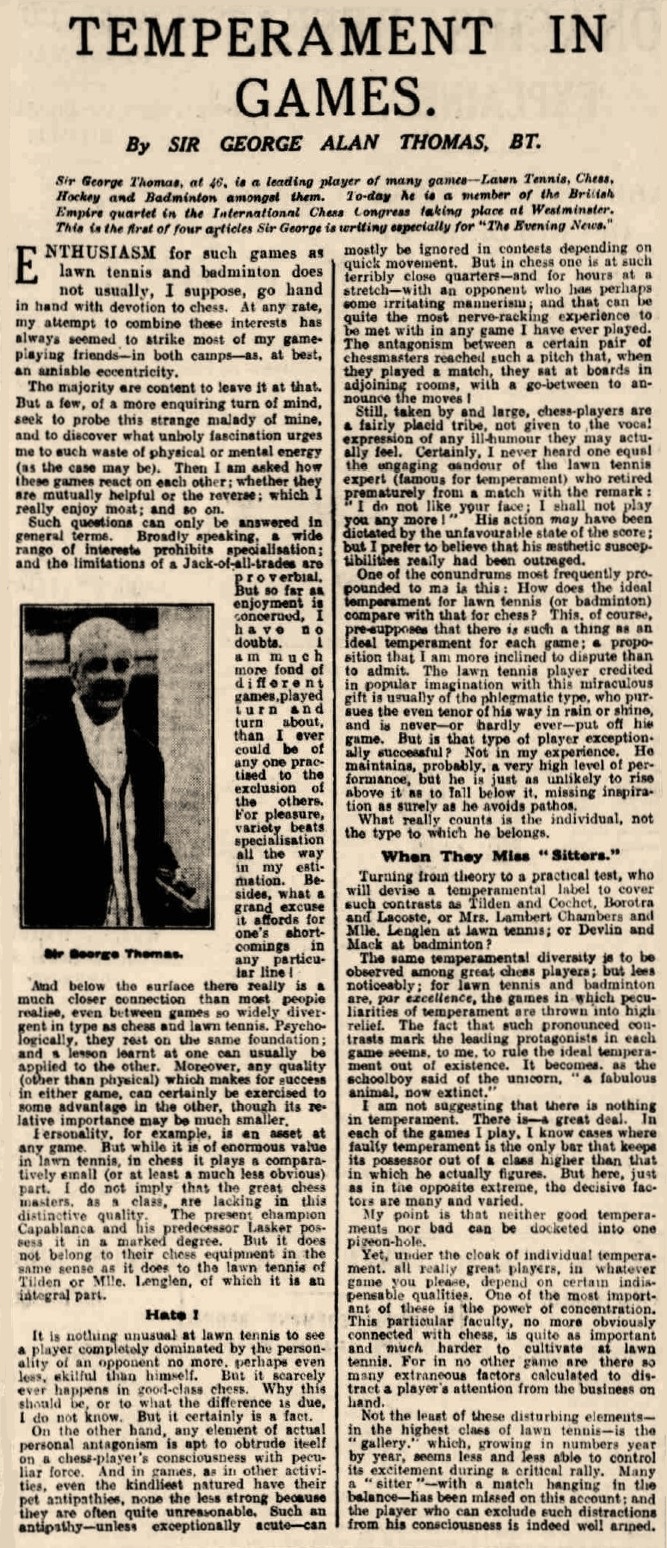
Addition on 19 February 2025:
Olimpiu G. Urcan adds this article on page 14 of The Evening News, 8 February 1935:
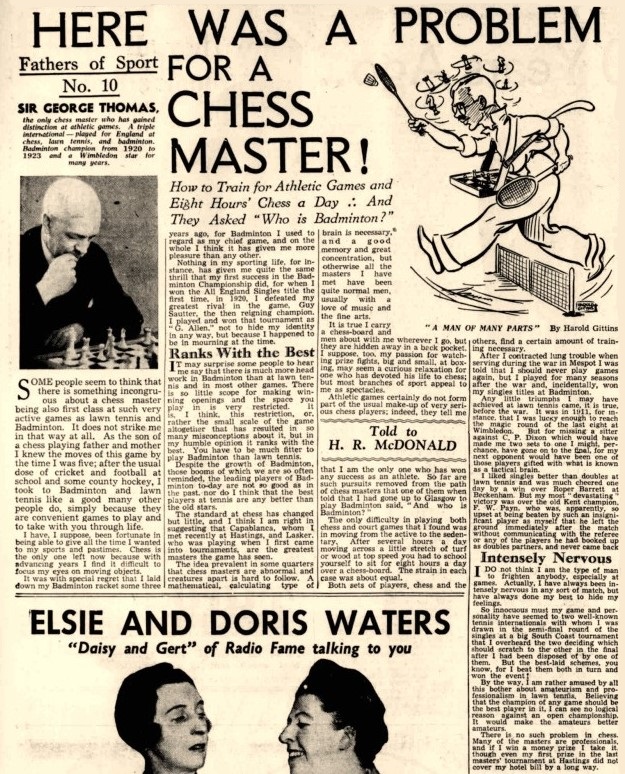
This ‘William Hickey’ column on page 4 of the Daily Express, 9 January 1935 has been forwarded by Jonathan Manley (Oxford, England), who is currently co-writing a book on Sir George Thomas with Tibor Károlyi:
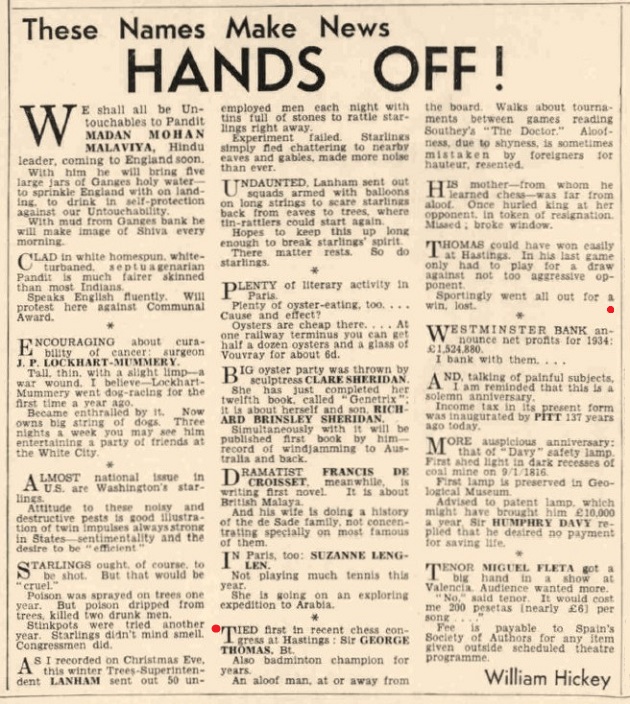
We hardly dare ask whether corroboration exists for the assertion that Lady Thomas ‘once hurled king at her opponent’ but, for form’s sake, the column is being added to Chess with Violence and ‘Once’.
Mr Manley notes that the ‘William Hickey’ column at the time was conducted by Tom Driberg (1905-76).
(12179)
To the Archives
for other feature articles.
Copyright Edward Winter. All rights reserved.